Bibliography of the reviews of publications in the years 2008 – 2013
 |
Abusir XXIX: The Shaft Tomb of Menekhibnekau II: The Texts
Renata Landgráfová, Ladislav Bareš, Diana Míčková Praha: Univerzita Karlova, Filozofická Karlova ISBN: 978-80-7671-080-1 The tomb of Menekhibnekau is one of the four large shaft tombs of the Saite-Persian period discovered in Abusir West. The volume presents the complete decoration of its burial chamber. The first part is dedicated to the inner greywacke sarcophagus with gate guardians and guardians of the Stundenwachen and the text of BD 72 on the chest exterior and a treaty of mutual protection with the sun god with divinization of the body parts of the deceased on the lid exterior (the interior of the inner sarcophagus was undecorated). The second part is dedicated to the outer sarcophagus, with mostly protective texts on the inside, and excerpts from the Coffin Texts, Pyramid Texts, the Book of the Dead and the glorification ritual on the outside. Notable are two texts invoking the protection of the divine mother: Mehetweret and her sever utterances on the western interior side of the lid, and Nut and Isis on the lid exterior, which only have parallels in the nearby tomb of Iufaa. The third part focuses on the decoration of the burial chamber with excerpts from the Pyramid Texts and the Book of the Dead. The appendices contain a preliminary overview of the process of the decoration of the tomb, synoptic hieroglyphic transcriptions of the texts known (only) from both Menekhibnekau’s and Iufaa’s tombs, an overview of the methods of documentation and a short chapter of the osteological remains of Menekhibnekau, which was not finished in time to be included in the first volume.
The publication can be purchased in the e-shop of the Faculty of Arts, Charles University.
|
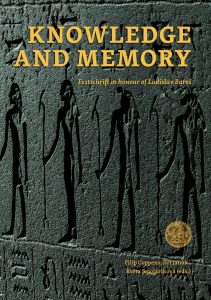 |
Filip Coppens – Jiří Janák – Květa Smoláriková (eds.), Knowledge and Memory. Festschrift in honour of Ladislav Bareš, Prague: Charles University, 2022.
ISBN 978-80-7671-088-7 519 pages, contents of the volume in PDF
The volume “Knowledge and Memory” serves as an appreciation of the career and achievements of Professor Ladislav Bareš on the occasion of his 70th birthday. The notions knowledge and memory correspond perfectly to the central focus of the religious and magical spells from the Late Period shaft tombs in Abusir, a subject that has always been close to the heart and mind of Ladislav Bareš. A collection of thirty-three papers, written by former students, numerous colleagues and friends, are hence devoted to themes closely aligned with Professor Bareš’ lifelong interest: the Memphite necropolis throughout the ages, and the Late Period (and beyond) throughout the whole of Egypt. The publication can be purchased in the e-shop of Faculty of Arts. |
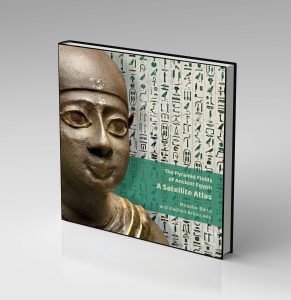 |
THE PYRAMID FIELDS OF ANCIENT EGYPT: A SATELLITE ATLAS
Editors: Miroslav Bárta and Vladimír Brůna With contributions by Adela Oppenheim and Dieter Arnold, The Metropolitan Museum of Arts, New York; Miroslav Bárta and Vladimír Brůna, Czech Institute of Egyptology, Charles University, Prague;Richard Bussmann, University of Cologne; Andrzej Ćwiek, University of Poznan; Veronika Dulíková, Czech Institute of Egyptology, Charles University, Prague; Peter Jánosi, University of Vienna; Mark Lehner, Ancient Egypt Research Associates and “Associate” at the Oriental Institute, University of Chicago; Mohamed Megahed, Czech Institute of Egyptology, Charles University, Prague; Massimiliano Nuzzolo, Institute of Mediterranean and Oriental Cultures, Polish Academy of Sciences, Warsaw; Stephan Seidlmayer, German Archaeological Institute, Cairo; Miroslav Verner, Czech Institute of Egyptology, Charles University, Prague and Josef Wegner, University of Pennsylvania, Philadelphia. ISBN 978-80-7671-053-5, 200 pp. with many coloured photographs and a complete set of satellite images of the respective pyramid fields. The principal aim of this publication is to provide for the first time a detailed scientific interpretation of high-resolution satellite images of all Old and Middle Kingdom pyramid sites of ancient Egypt. The sites included in this Atlas represent to a large degree the principal sites of the history of the Third to Thirteenth Dynasties. Their particular characteristics mirror the specific periods of Egyptian history and in a way may be considered as genuine time capsules providing fascinating windows into the incredible story of ancient Egypt. The sites include (starting in the north): Abu Rawash, Giza, Zawiyet el-Aryan, Abusir, Saqqara, Dahshur, Mazghuna, Lisht, Meidum, Lahun, Hawara and Abydos. The site of Abu Ghurob with the two sun temples of Userkaf and Nyuserra of the Fifth Dynasty was also covered as well as the so-called minor step pyramids dating from the late Third – early Fourth Dynasty which start in Seila at the northeastern edge of the Faiyum Oasis and include those of Zawyet Sultan, Nubt (Naqada), Abydos (Sinki), Hierakonpolis (el-Kula), Edfu (Ghonemeia) and Elephantine. The publication is available through Oxbow Books or the Czech Institute of Egyptology. |
 |
Sluneční králové / Kings of the Sun
Miroslav Bárta, Jiří Janák, Renata Landgráfová (eds.) Prague: Faculty of Arts, Charles University 2021. ISBN 978-80-7671-052-8; 284 pages. The catalogue accompanied the unique exhibition Kings of the Sun that took place at the National Museum in Prague between September 1st 2020 and September 31st 2021 and mapped over a century of archaeological exploration of the site of Abusir by Egyptian, German and Czech (until 1990 Czechoslovak) missions. It contains 139 entries on almost 300 objects dating between the Early Dynastic and Ptolemaic Periods, including examples from the royal burial equipment of King Raneferef from the pyramid cemetery, sculptures of the priest Nefer and Princess Sheretnebty from Abusir south, as well as items from the Saite-Persian shaft tombs. The objects tell a story of the ancient Egyptian civilization and of the people who formed it, and through them, the catalogue maps the existence and development of the the site of Abusir for almost three millennia. Book is available in the e-shop of the Faculty of Arts, Charles University, and in the bookstore Karolinum. |
 |
Continuity, Discontinuity and Change. Case studies from the New Kingdom to the Ptolemaic and Roman Era
Coppens, Filip (ed.), Prague: Faculty of Arts, Charles University 2021. ISBN 978-80-7671-048-1; 580 pages. The volume focuses on different methods and strategies employed by individuals and/or communities when confronted with major changes in society and its reflection in the material culture. The first part concentrates on developments and transformations observable in New Kingdom private tombs commissioned by non-royal individuals in the three main cemeteries of the time – Amarna, Thebes and Saqqara – during the period immediately before, during and after the “Amarna age”. The second part of the volume centres on various strategies of adaptation and modification, as reflected on the level of the priesthoods and the design of the temple program (architecture, text and image) during the Ptolemaic and Roman period. Contents of the volume in PDF. Book is available in the e-shop of the Faculty of Arts, Charles University, and in the bookstore Karolinum. |
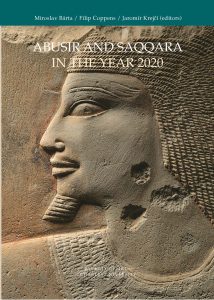 |
Abusir and Saqqara in the Year 2020
Bárta Miroslav – Coppens Filip – Krejčí Jaromír – editors Prague: Charles University, Faculty of Arts 2021
The Czech Institute of Egyptology of the Charles University has since the start of the third millennium established the tradition of organising on a regular basis a platform for scholars, active in the pyramid fields and the cemeteries of the Memphite region (Abusir, Saqqara, Dahshur and Giza in particular). The present volume, the fifth in the series, contains 30 contributions by 35 scholars, reflecting the widespread, often multidisciplinary interest of researchers into a wide variety of different topics related to the Memphite necropoleis. Individual contributions include some of the latest results of archaeological explorations, new interpretations of archaeological evidence within the framework of social and environmental development and climate change, new approaches to long-known texts and inscriptions, the application of modern computer-based analyses of the society of the day, as well as newly understood historical, social and landscape connotations of some sites and monuments. Contents of the volume in PDF. Book is available in the e-shop of the Faculty of Arts, Charles University and in the online bookshop of Karolinum |
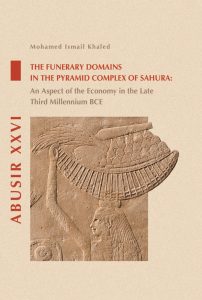 |
Abusir XXVI: The Funerary Domains in the Pyramid Complex of Sahura: An Aspect of the Economy in the Late Third Millennium BCE
Mohamed Ismail Khaled Prague, Charles University, Czech Institute of Egyptology 2020. 208 p. ISBN: 978-80-7308-998-6. The book presents the reader the richest corpus of Old Kingdom royal funerary domains. The core of the book represents catalogue of funerary domains retrieved during recent archaeological works by Egyptian team at Sahura’s causeway and of related pehou regions. The introductory chapters provide the reader with the context and the overview of other known contemporary domains of this kind. The concluding chapters then discuss the nature and location of pehou regions as well as the economic significance of royal domains with regard to the new finds from Sahura’s causeway. Contents of the volume in pdf. The book can be purchased in the e-shop of the bookstore Karolinum and in the e-shop of the Faculty of Arts. |
 |
Economic Complexity in the Ancient Near East. Management of Resources and Taxation (Third – Second Millennium BC)
edited by Jana Mynářová and Sergio Alivernini
Prague: Charles University, Faculty of Arts 2020 ISBN: 978-80-7308-991-7 Hardcover, 471 pages Price: 55 Euro
Abstract: The spread of cuneiform writing from its Mesopotamian heartland to the peripheries during the second half of the third, and especially in the second millennium BC, represents an important historical and cultural phenomenon. From the beginning of the second millennium BC cuneiform writing became the privileged means through which the administrations of these “peripheral” centers recorded economic transactions. These documents (taxes, rations, sales, etc.) shed a fascinating light on the economic system in these regions. Thousands of administrative documents allow us to follow the process of the development of economic thought that, starting from Mesopotamia, was taken and adapted to specific administrative realities throughout the wider regions of the Ancient Near East. The 19 essays collected here elucidate the emergence, transmission, and interaction of economic structures and the management of resources in time and space. Through a diachronic study, the volume identifies similarities, differences, and adaptations in the economic management of resources and taxation in the Ancient Near East (third – second millennium BC) |
 |
Janice Kamrin, Miroslav Bárta, Salima Ikram, Mark Lehner, and Mohamed Megahed (editors)Guardian of Ancient Egypt: Studies in Honor of Zahi Hawass, Volumes I-IIICharles University, Prague, Faculty of Arts 2020Guardian of Ancient Egypt: Essays in Honor of Zahi Hawass offers 101 significant contributions to Egyptology. Written by many of the seminal scholars in the field to celebrate one of the most renowned archaeologists in the world, the articles in these three volumes cover a ranges of themes, sites, and artifacts. A must-have for any Egyptological library, these essays, beautifully illustrated in full color, will appeal to both scholars and lovers of ancient Egypt. Contents in PDF.Book is available in the e-shop of the Faculty of Arts, Charles University and in the e-shop of the bookstore Karolinum. |
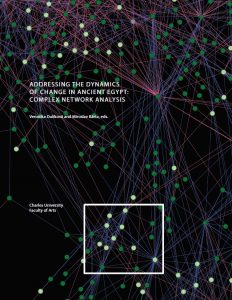 |
Veronika Dulíková, Miroslav Bárta (editors)
Addressing the Dynamics of Change in Ancient Egypt: Complex Network Analysis Charles University, Prague, Faculty of Arts 2020 The present volume seeks to indicate novel methods and approaches to analysing and interpreting the agency of individual officials in different periods of ancient Egyptian history. Their activity and careers are observed using different methods of complex network analysis and put into a broader framework of more general trends operating the society at a given stage of its evolution. We are confident that this is one of the most promising and proven ways to gain deeper insights into day-to-day lives of the people of the past. The story of civilisations is above all a story of ideas and thoughts, and social/complex network analysis is one of the most efficient tools we can use. It enables us to view known data anew and assess them from new perspectives that significantly expand and deepen our knowledge of the past civilisation. In recent years, this research approach has evolved independently at several institutions exploring ancient Egypt. We were very pleased to host most of these scholars at a joint meeting and offer them an opportunity to present and communicate their individual approaches, methods, points of view and observations. The contributions in this volume, originally presented at a workshop in Prague in September 2018, cover selected periods of ancient Egypt (the Old Kingdom, the New Kingdom, the Greco-Roman Period). Cyber-Egyptology, a new area of research in Egyptology, appears to be a justified approach with its own methodology, philosophy and a vast potential to answer complex questions relating to this fascinating civilisation and its diachronic dynamics. Moreover, this method of cyber-research can be applied universally across most archaeological and historical specialisations. Book is available in the e-shops of the Faculty of Arts, Charles University, and bookstore Karolinum. |
 |
†Eugen Strouhal
Wadi Qitna and Kalabsha-South: Late Roman – Early Byzantine Tumuli Cemeteries in Egyptian Nubia. Volume II – Anthropology (with contributions by Hans Barnard, Petra Havelková, Jaroslav Jambor, Přemysl Klír, Alena Němečková, †Vladimír Novotný, Karel Preuss, Milan Salaš, Václav Smrčka, Lenka Varadzinová and †Luboš Vyhnánek) Edited by Lenka Varadzinová and Petra Havelková Charles University, Faculty of Arts, Prague 2020 The present publication follows Volume I of 1984 that presented the results of a comprehensive archaeological investigation of two tumulus cemeteries of the Late Roman and Early Byzantine Period (third–fifth centuries AD) explored by the Czechoslovak Institute of Egyptology (Charles University in Prague) in the scope of the UNESCO-organised salvage campaign called for in advance of the ultimate submersion of Nubia by the waters of the High Aswan Dam. This Volume II evaluates the human skeletal remains of 558 individuals from the completely explored cemetery at Wadi Qitna (456 tumuli) and a comparative sample of 35 individuals from the near-by cemetery at Kalabsha-South (19 tumuli) from the point of view of social, cultural and physical anthropology. It provides the evidence of their social structure as well as an insight into the life of the people and their family relationships. A comparison of the physical-anthropological features of the community with other contemporaneous and antecedent series using univariate and multivariate methods reveals their mutual position. The final chapter provides a brief overview of the history of the northern part of Egyptian Nubia and an up-to-date report on the handmade pottery found in large numbers at Wadi Qitna and Kalabsha-South, whose distribution has since been attested at many sites in the Nile Valley, on the Red Sea coast and in the Eastern Desert of Egypt and the Sudan. The volume touches upon the complex social and ethnic processes that were taking place in the frontier region between Egypt and Nubia during the critical centuries separating the Antiquity and Medieval Period and opens paths to their further research. The text is accompanied by 111 tables, 78 figures and maps, 41 photographic and documentary plates and 5 appendices. The book is available in the e-shop of the Faculty of Arts. |
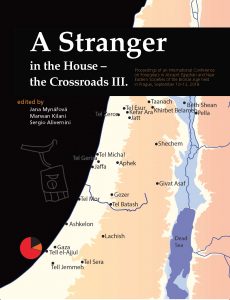 |
Mynářová, Jana – Kilani, Marwan – Alivernini, Sergio (eds.)
A Stranger in the House – the Crossroads III. Proceedings of an International Conference on Foreigners in Ancient Egyptian and Near Eastern Societies of the Bronze Age held in Prague, September 10-13, 2018 Prague: Charles University, Faculty of Arts, 2019 The Crossroads III – A Stranger in the House. Foreigners in Ancient Egyptian and Near Eastern Societies of the Bronze Age conference has been held at the Faculty of Arts, Charles University (Prague) between September 10 and 13, 2018. The main objective of the conference was to enhance our understanding of “foreignness” in ancient societies between the end of the Chalcolithic period and the end of the Late Bronze Age. This book collects some of the twenty most significant contributions presented at the conference. Some authors decided to approach the discussion from a theoretical perspective, or to present and discuss theoretical frameworks that could be used to explore at least some elements underlying the concept of “foreignness”. Others investigated sociocultural dimension involved in the presence of foreigners, or in their interactions with local communities. Cases from Egypt, Mesopotamia, Anatolia, and the Levant, covering the whole of the Bronze Age have been discussed. The wide range of perspectives, and their combination within the frame of the conference often stimulated that multidisciplinary dialogue that was the primary aim of this third edition of Crossroads. Hadcover, 435 pp. ISBN: 978-80-7308-928-3 |
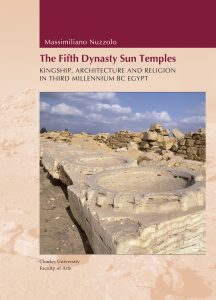 |
Massimiliano Nuzzolo
The Fifth Dynasty Sun Temples. Kingship, Architecture and Religion in Third Millenium BC Egypt Charles University, Prague, Faculty of Arts 2019 The sun temples of the Fifth Dynasty are an unparalleled monument of ancient Egypt which characterized the central part of the Old Kingdom, usually considered as the apex of the solar cult and theology. Yet, the issues of their actual meaning, original architectural shape and ideological influence on the later phases of Egyptian history are far from clear, as well as their cultic, ideological and symbolic relationship with the contemporary pyramids and with what is considered to be the original place of rise and diffusion of the solar cult in ancient Egypt, i.e., the city of Heliopolis. Six temples were built in a quite limited time span in the middle of the Third Millennium BC but only two have been discovered so far. Where are, thus, the missing ones? All these questions, and many others, are addressed by the present book, which represents the first complete publication on the sun temples matter. The volume collects all the available archaeological and textual evidences related to these monuments, including an in-depth reconstruction of the original decoration of the temples and a rich prosopography of the people involved with their running. Several tables, sheets and plates, with photographs of the monuments and the main related documents, also enrich the publication. |
 |
Peter Jánosi a Hana Vymazalová (eds.)
The Art of Describing. The World of Tomb Decoration as Visual Culture of the Old Kingdom. Studies in Honour of Yvonne Harpur Charles University, Prague, Faculty of Arts 2018 The superbly illustrated volume “The Art of Describing” presents a wide array of subject-matter dealing with the visual culture of the Old Kingdom. The topics range from many in-depth studies of various two-dimensional motifs as well as sculpture encountered in the tombs of the Memphite necropolises, the presentation of complete overviews of wall scenes, and the art of carving, to selected royal scenes as well as the decorative programme of burial chambers. Many of the issues touch upon hitherto unpublished material and tombs only recently discovered. The book was compiled in honour of Yvonne Harpur, the doyenne of the study of art and decoration of tombs from the pyramid age. Her life-long passion for tomb decoration and scenes details have influenced and helped students and scholars around the world. Thus, the contributions collected in this album amicorum not only reflect the great interest but also the potential in dealing with the art of the Old Kingdom. Contents of the volume: |
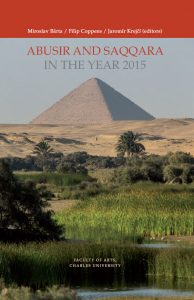 |
Miroslav Bárta – Filip Coppens – Jaromír Krejčí (eds.)
Abusir and Saqqara in the Year 2015 Charles University, Fauclty of Arts, Prague 2017
The Czech Institute of Egyptology of the Charles University in Prague has since the start of the third millennium established the tradition of organizing on a regular basis a platform for scholars, active in the pyramid fields and the cemeteries of the Memphite region (Abusir, Saqqara, Dahshur and Giza in particular), to meet, exchange information and establish further cooperation. |
 |
Miroslav Verner
Abusir XXVIII. The Statues of Raneferef and the Royal Sculpture of the Fifth Dynasty Charles University in Prague, Faculty of Arts, Prague 2017 Czech archaeological team discovered in the mortuary temple of Raneferef in Abusir in the 1980s fragments of about a dozen of the statues of the king, including his six complete likenesses. The monograph presents a detailed description and discussion of Raneferef’s statues in the broader context of the royal sculpture of the Fifth Dynasty. The publication can be purchased through the e-shop of the Faculty of Arts, Charles University or e-shop of the book shop Karolinum.
|
 |
Renata Landgráfová – Jana Mynářová (eds.)
Rich and great : studies in honour of Anthony J. Spalinger on the occasion of his 70th feast of Thoth Charles University in Prague, Faculty of Arts, Prague 2016 Egyptology, like other related disciplines, is becoming more and more specialized. Scholars are focussing on topics limited in scope and restricted to a particular area of research. The time when an Egyptologists was able to hold his own on several diverse aspects of the subject is almost gone. This is a logical consequence of the unprecedented growth and expansion of contemporary scholarship and of the requirements of the ruthless competition for jobs. Yet there still are some whose breadth as well as depth of knowledge astonish. Professor Anthony John Spalinger to whom the present volume is dedicated belongs to that rare breed.
|
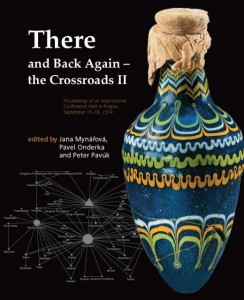 |
Jana Mynářová – Pavel Onderka – Peter Pavúk (eds.) There and Back Again – the Crossroads II. Proceedings of an International Conference Held in Prague, September 15–18, 2014 Charles University in Prague, Faculty of Arts, Prague 2015 The volume brings the proceedings of the second international conference entitled There and Back Again – the Crossroads II, dedicated to the study of relations between Egypt, the Aegean, the Levant, and the Sudan in the second and first millennia BCE. The conference took place September 15–18, 2014 at the Faculty of Arts, Charles University in Prague. The present volume contains 24 studies divided into four sections – Methods and Technologies, Egypt and the Aegean – the Iconography, Problems of the 2nd millennium BCE and Problems of the 1st millennium BCE. |
 |
Hana Navrátilová – Renata Landgráfová
Sex and Golden Goddess II. World of the Love Songs Charles University in Prague, Faculty of Arts, Prague 2015
Ancient Egyptian love songs have attracted and puzzled reseachers ever since they were first read. The second volume of the Golden Goddess series includes papers concerning the aspects of the world of Egyptian literary texts, but also cultural history and sensibilities of the ancient civilization – themes addressed include Begriffsgeschichte, textual analysis, literary studies, as well as concerns of historical anthropology and of reconstructing ancient individual biographies. All three major papyri with the love songs, P. Chester Beatty I, P. Harris 500 and P. Turin 1966 are reproduced on colour plates, shown together for the first time. Ancient Egyptian love songs have attracted and puzzled reseachers ever since they were first read. The second volume of the Golden Goddess series includes papers concerning the aspects of the world of Egyptian literary texts, but also cultural history and sensibilities of the ancient civilization – themes addressed include Begriffsgeschichte, textual analysis, literary studies, as well as concerns of historical anthropology and of reconstructing ancient individual biographies. All three major papyri with the love songs, P. Chester Beatty I, P. Harris 500 and P. Turin 1966 are reproduced on colour plates, shown together for the first time. |
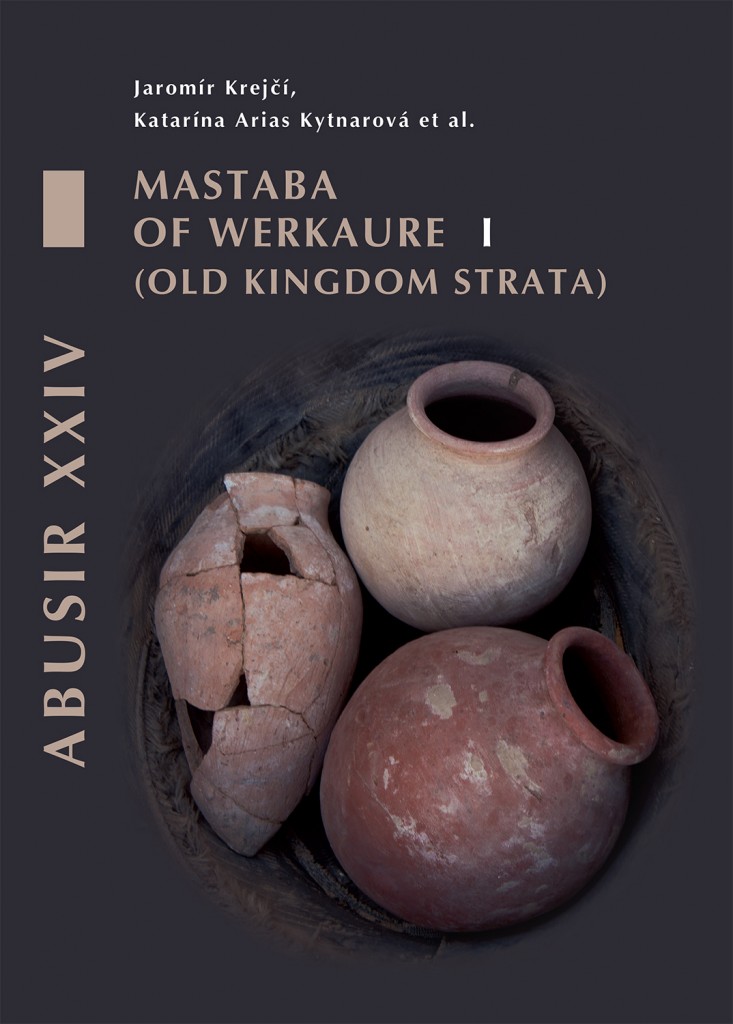 |
Jaromír Krejčí – Katarína Arias Kytnarová – Hana Vymazalová – Adéla Pokorná – Jaromír Beneš Abusir XXIV. Mastaba of Werkaure. Vol. 1: Tombs AC 26 and AC 32 – Old Kingdom Strata Charles University in Prague, Faculty of Arts, Prague 2014 The monograph evaluates results of the archaeological research of the area of the Fifth-Dynasty Tomb AC 26 (formerly known as Pyramid Lepsius no. 23) and Late Sixth-Dynasty Tombs AC 32 carried out by the Czech Institute of Egyptology during three archaeological seasons from 2006 until 2009. The publication focuses on archaeological contexts dated to the Old Kingdom. Tomb AC 26 is located next to the pyramid complex of Queen Khentkaus II – in the centre of the royal necropolis – it thus demonstrates an important position of its tomb owner. It is also one of the most devastated monuments in the Abusir royal necropolis. This fact made the field work and the evaluation of its results rather difficult. Regardless of its large-scaled destruction it was possible to ascribe Tomb AC 26 to “the Eldest son of the King”, Werkaure. Individual chapters of the book deal with the description and evaluation of the architecture of the tombs, finds datable to the Old Kingdom, a large collection of pottery, masons’ inscriptions and signs, archaeobotanical analyses of macroremains from mud bricks and conclusions – concerning especially dating of the Tombs AC 26 and AC 32. Format: 304 pages, 24 pages of full-colour plates, A4, hardback. |
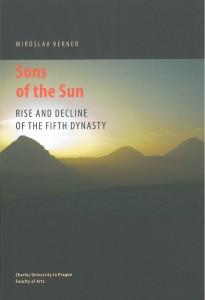 |
Miroslav Verner Sons of the Sun. Rise and Decline of the Fifth Dynasty Charles University in Prague, Faculty of Arts, Prague 2014 The monograph deals with the so far unclear decline of the 4th and the legend-clouded rise of the new royal family in the Fifth Dynasty, the reign of individual kings of the dynasty and their efforts to cope with the growing power of the bureaucracy and develop principal state institutions, royal mortuary cults, etc. |
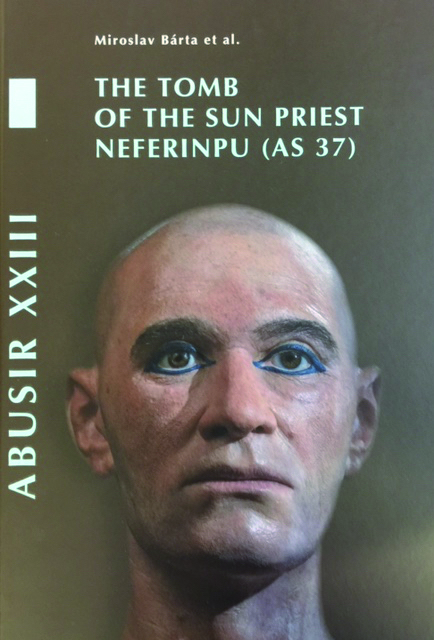 |
Miroslav Bárta et al. The tomb of the sun priest Neferinpu (AS 37) Charles University in Prague, Faculty of Arts, Prague 2014 This publication is the latest monographic outcome of a long-term project of survey and research of the archaeological site of Abusir, focusing on a particular set of cemeteries located at Abusir South. The present volume of the Abusir series concentrates on the mastaba of Neferinpu (AS 37). It aims to present primary data and their basic analysis and interpretation acquired during the tomb examination by the Czech Institute of Egyptology during two subsequent seasons of 2006 and 2007 and followed by some minor campaigns in 2012 and 2013 and a specific analytical campaign in September 2014 carried out by the Japanese team from Tokyo University of Science. The mastaba was built by a sun priest and official Neferinpu who reached the peak of his career during the reign of Nyuserra and Djedkara. |
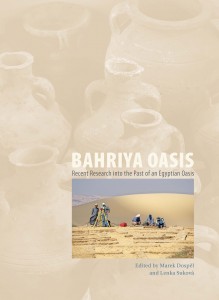 |
Marek Dospěl – Lenka Suková (eds.) Bahriya Oasis. Recent Research into the Past of an Egyptian Oasis Charles University in Prague, Faculty of Arts, Prague 2013 Through its 14 chapters, this book presents the outcomes of the recent exploration of Bahriya, an Egyptian oasis located in the Western Desert about 350 km south-west of Cairo. Part I of the volume is devoted to the southern part of the Oasis (also known as El-Hayz) and the exploration carried out there by the team led by the Czech Institute of Egyptology, Charles University in Prague. Part II concentrates on the northern part of the same oasis bringing forth the results of scholarly research by the French team led by Université de Strasbourg. Complementing the two parts is Part III with the final chapter which deals with water-management in the Western Desert as a whole. Containing chapters written by archaeologists, Egyptologists, philologists and natural scientists, this richly illustrated book attempts at providing as comprehensive picture of the past of the Bahriya Oasis as can be drawn from the hitherto research, encompassing a wide range of aspects from settlement history and environment to material culture and written evidence. |
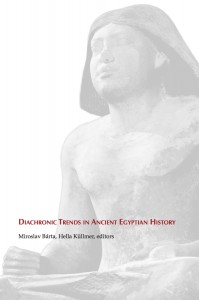 |
Miroslav Bárta – Hella Küllmer (eds.) Diachronic trends in Ancient Egyptian History. Studies dedicated to the memory of Eva Pardey Charles University in Prague, Faculty of Arts 2013 Studies dedicated to the memory of Eva Pardey. The book includes contributions of the following authors: Hartwig Altenmüller, Ladislav Bareš, Miroslav Bárta, Andreas Effland, Martin Fitzenreiter, Hans Goedicke, Peter Jánosi, Dieter Kurth, Christian Loeben, Juan Carlos Moreno García, Jana Mynářová, Anthony Spalinger, Miroslav Verner, Hana Vymazalová, Wolfgang Waitkus. |
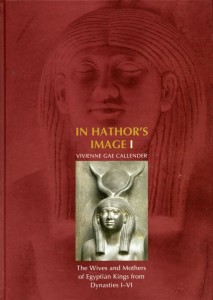 |
Vivienne Gae Callender In Hathor’s Image I. The Wives and Mothers of Egyptian Kings from Dynasties I-VI Charles University in Prague, Faculty of Arts, Prague 2012 This study of individual Egyptian queens is based on an earlier study, The Wives of the Egyptian Kings, Dynasties I-XVII, which was a doctoral dissertation ny this author presented at Macquaire University in 1992. This book differs from the first in many ways because we now understand much more abou these royal women. xviii, 405 pages, 122 b/w illustrations. |
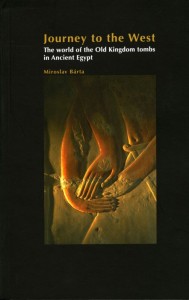 |
Miroslav Bárta Journey to the West. The world of the Old Kingdom tombs Charles University in Prague, Faculty of Arts, Prague 2012 This book is intended as a commented summary of some of the major trends and most important features that can be encountered when analysing ancient Egyptian society of the Old Kingdom. We have to bear in mind that around 3000 BCE one of the first centralised states in our recorded history rose, and the Old Kingdom represents certainly one of its apogees. Moreover, there is hardly any comparable society that left behind such a wealth of archaeological and literary evidence, a welcome companion for our journey back in time. The goal for writing this book was to outline general trends in the history of the non-royal tomb development of the period. The reason is rather simple and straightforward: ancient Egyptians considered the tomb to be their afterlife residence for eternity. In the afterlife they replicated the life they experienced during the lifetime. Thus the tomb architecture, decoration, inscriptions and equipment paradoxically represent a major tool for our understanding of the everyday life of the ancient Egyptians and enable a better comprehension of the development and dynamics of the Old Kingdom. The book is divided into nine chapters covering, step by step, the development of the Egyptian tomb and society from the Predynastic Period to the end of the first six Egyptian dynasties, a lengthy period of time which covers the Early Dynastic and the Old Kingdom periods. These six chapters are accompanied by three additional chapters on religious aspects of the Old Kingdom society, its economy and environment. 342 pages. Reviews:– Nigel Strudwick, Egyptian Archaeology 42, 2013 |
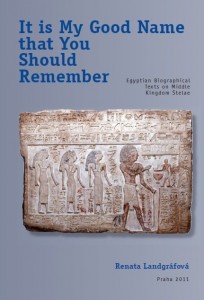 |
Renata Landgráfová (with a contribution by Hana Navrátilová) It is My Good Name That You Should Remember. Egyptian Biographical texts on Middle Kingdom Stelae Charles University in Prague, Faculty of Arts, Prague 2011 The volume represents the first part of a planned two-volume series. It presents biographical texts from stelae of Dynasties 11-12 in hieroglyphs, transliteration and translation. The texts are arranged by dynasty, and within the two dynasties by provenance. The second volume will contain biographical texts on tomb walls and rocks, as well as detailed commentaries to texts presented in both volumes. |
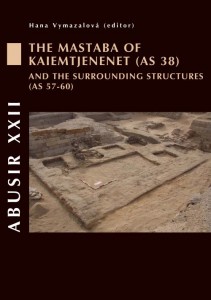 |
Hana Vymazalová (with contributions by Katarína Arias Kytnarová, Jaromír Beneš, Aleš Bezděk, Helena Březinová, Adéla Pokorná, Zdeňka Sůvová, Hana Šuláková, Ladislav Varadzin, Pavla Zedníková Malá) Abusir XXII. The Tomb of Kaiemtjenenet (AS 38) and the surrounding structures (AS 57-60) Charles University in Prague, Faculty of Arts, Prague 2011 The volume is dedicated to several small tombs built of mud-bricks, which are located to the east of the mastaba of vizier Qar and west of the mastaba of Neferinpu in Abusir South. The tomb of Kaiemtjenenet dates to the late Fifth Dynasty, and both earlier and later structures were identified not only around it but also underneath. In addition, several Sixth Dynasty structures were constructed to the east and north-east of the tomb. The volume presents the archaeological report, including the analysis of the pottery finds, anthropological material, and organic finds. |
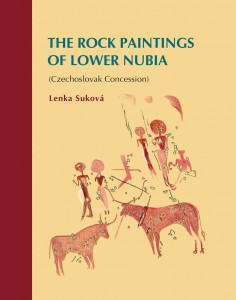 |
Lenka Suková The Rock Paintings of Lower Nubia (Czechoslovak Concession) Charles University in Prague, Faculty of Arts, Prague 2011 The monograph is the first exhaustive publication of nine shelters with rock paintings documented by the Czechoslovak expedition in Lower Nubia in the scope of the UNESCO-organised salvage campaign. The presentation of each of the painted shelters includes description of the landscape setting and physical characteristics of the rock surfaces, analyses of the thematic, stylistic, syntactic, and technical aspects of the rock art, discussion of the spatial and temporal dynamics of the rock-art surface, and evaluation of the significance of the evidence. The final chapter offers some thoughts on the overall significance of the rock paintings from the Czechoslovak concession as one of the artistic and cultural expressions of the populations that inhabited Lower Nubia in different periods of the past and as historical documents about their past worlds and lives. Part of the book is a large-format (70 × 100 cm) colour plate with a reconstruction of one of the most exquisite occurrences of rock paintings in Lower Nubia, the so-called “Painted Shelter at Korosko”. |
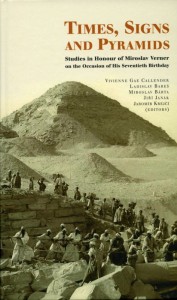 |
Vivienne Gae Callender – Ladislav Bareš – Miroslav Bárta (eds.) Times, Signs and Pyramids. Studies in Honour of Miroslav Verner on the Occasion of His Seventieth Birthday Charles University in Prague, Faculty of Arts, Prague 2011 A collection of articles in honour of Miroslav Verner. |
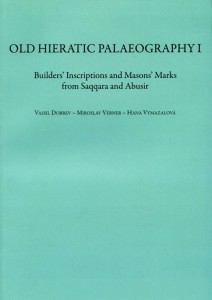 |
Hana Vymazalová – Vassil Dobrev – Miroslav Verner Old Hieratic Palaeography I. The Builders‘ Inscriptions and Mason’s Marks from Saqqara and Abusir Charles University in Prague, Faculty of Arts, Prague 2011 More than a century after the publication of the first volume of the pioneer work by G. Möller, the authors have studied in detail a hitherto largely neglected group of sources – builders‘ inscriptions and masons‘ marks. The first volume of a planned series of Old Kingdom Hieratic Paleography thus represents a unique tool for work with these types of inscriptions, and an important broadening of our knowledge of the ancient Egyptian script. 73 pages. Reviews:– Gloria Rosati, Orientalia 82/1, 2013, s. 11–12 |
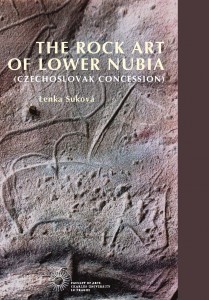 |
Lenka Suková The Rock Art of Lower Nubia (Czechoslovak Concession) Charles University in Prague, Faculty of Arts, Prague 2011 The present publication is concerned with the rock art from two sections of the Nile Valley in Lower Nubia surveyed in the scope of the UNESCO-organised salvage campaign by the Czechoslovak Institute of Egyptology (Charles University in Prague). It has two main objects, first to complete the catalogue of the rock art documented or localised in the two sections of the Czechoslovak concession with hitherto unpublished rock-art surfaces and occurrences (both petroglyphs and rock paintings) and, second, to provide a critical revision of the data published in Katalog der Felsbilder aus der Tschechoslowakischen Konzession in Nubien (edited by F. Váhala and P. Červíček, Prag 1999). With the two objects accomplished, the present publication constitutes a kind of manual to the rock-art corpus from the Czechoslovak concession in Lower Nubia and is to be regarded, together with Katalog, as the complete and authoritative source of data for evaluation of the significance of the evidence from the two sections of the Nile Valley in Lower Nubia. The textual part is accompanied by hitherto unpublished distribution maps of the corpus, 155 hitherto unpublished black-and-white photographs, and four colour plates with the sheets of the colour scale used for the recording of patina difference or colour value of preserved paints. Reviews:– Wouter Claes, Bibliotheca Orientalis LXXIII/1-2 (2016), 107-108 |
| Anthony Spalinger Icons of Power. A strategy of reinterpretation Charles University in Prague, Faculty of Arts, Prague 2011 A discussion of the concept of alterity and icons in the Egyptian New Kingdom war reliefs. Also covered is the concept of drama, and how it is present in these narrative representations. 228 pages. |
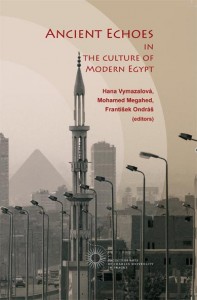 |
Hana Vymazalová – Mohamed Megahed – František Ondráš (eds.) Ancient Echoes in the Culture of Modern Egypt Charles University in Prague, Faculty of Arts, Prague 2011 The book presents selected aspects of the legacy that ancient Egypt left on the culture of Coptic, Islamic and modern Egypt. Ancient origin can be traced in numerous different sources and thus the papers in the volume approach the subject from different perspectives. Many connections can be found in the Egyptian traditions in general, as well as in certain specific practices. Inspiration by the ancient times is also very apparent in literature and art. Format B5, 244 pages, paperback. Text in English and Arabic. |
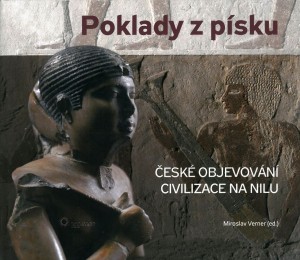 |
Miroslav Verner (ed.) Poklady z písku. České objevování civilizace na Nilu / Treasures from the Sand. Czech Discovering of the Civilization on the Nile Charles University in Prague, Faculty of Arts, Prague 2011 In the course of more than half a century of ongoing Czech egyptological explorations in Egypt a number of new epigraphic and archaeological sources were discovered, among which are artifacts belonging to the highlights of ancient Egyptian art and crafts. These artifacts are presented in the book Treasures from the Sand. Note: Book in Czech. |
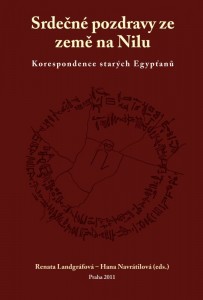 |
Renata Landgráfová – Hana Navrátilová (eds.) Srdečné pozdravy ze země na Nilu. Korespondence starých Egypťanů / Greetings from the Land onthe Nile. Ancient Egyptian Correspondence Charles University in Prague, Faculty of Arts, Prague 2011 The book contains commented translations and accompanying studies of letters from the entire ancient Egyptian history, from the beginnings of Egyptian correspondence in the Old Kingdom to the last examples from the Byzantine Period. It thus covers almost 3000 years of ancient Egyptian correspondence and as such is unique not just in the Czech environment, but also internationally. The volume also contains chapters on international correspondence and on copies of letters in monumental form. Format: A5, hardback; in Czech. |
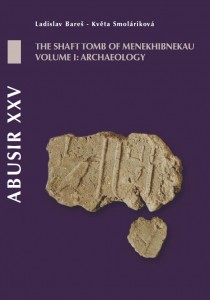 |
Ladislav Bareš – Květa Smoláriková The shaft tomb of Menekhibnekau. Vol. I: Archaeology Charles University in Prague, Faculty of Arts, Prague 2011 The first volume includes the description of the archaeological situation and finds from the main burial chamber and the subsidiary shafts(L. Bareš), including the embalmer’s deposit found in a separate shaft (K. Smoláriková). Separate chapters deal, among others, with the pottery (K. Smoláriková), the person of Iufaa and his family (L. Bareš), as well as with the texts from the embalmer’s deposit (R. Landgráfová and J. Janák), Phoenician and Aramaic inscriptions on a Phoenician storage jar (J. Dušek and J. Mynářová) and xylotomic analysis of wooden objects from the embalmer’s deposit (J. Beneš). The second volume is currently in preparation and will be dedicated to the texts and decoration on the walls of the burial chamber and sarcophagi of Menekhibnekau. Format: A4, hardback. |
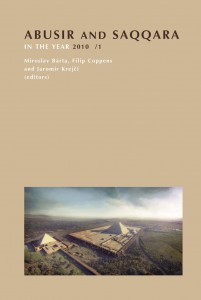 |
Miroslav Bárta – Filip Coppens – Jaromír Krejčí (eds.) Abusir and Saqqara in the Year 2010 (2 volumes) Charles University in Prague, Faculty of Arts, Prague 2011 The Czech Institute of Egyptology of the Charles University in Prague has since the start of the third millennium established the tradition of organising on a regular basis a platform for scholars, active in the pyramid fields and the cemeteries of the Abusir-Saqqara-Dahshur region, to meet, exchange information and establish further cooperation. The present two part volume, containing 51 contributions in total, is the result of the already third “Abusir and Saqqara” conference held in late May and early June 2010. The volume reflects the widespread, often multidisciplinary interest of many researchers into a wide variety of different topics related to the region of Abusir, Saqqara and Dahshur. The focus of the majority of the articles is on these cemeteries of the Memphite region at the time of the Old Kingdom, but not a single period is left untouched. A number of articles also move outside the core region, studying material and developments elsewhere in Egypt, but always against the background of the Memphite necropolis. In English, German and French. Format: Hardback B5, 904 pages and 45 colour plates. |
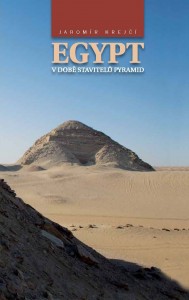 |
Jaromír Krejčí Egypt during the time of the pyramid builders Charles University in Prague, Faculty of Arts, Prague 2011 Pyramids are icons of ancient Egypt. To create them, a combination of natural conditions in the Nile valley and the functioning of a strictly hierarchical society was needed. On the top of this society there was the ruler – the only living god on earth. This publication presents and describes – in the form of a mosaic – pyramid complexes, tombs and temples as well as the life and socio-cultural development of ancient Egyptian society, the sovereign status, religious ideas, and life of high dignitaries as well as that of ordinary people. Attention is also given to the natural environment and its influence on the Nile civilization. More than 4000 years which have passed since the period of pyramid builders represent a very difficult gap to overcome. Generations of Egyptologists, to whom the author of this book belongs, keep endeavouring to do it. Thus, curious readers can be at least partially satisfied.Format: 344 pages, ISBN 978-80-7308-368-1, text in Czech. |
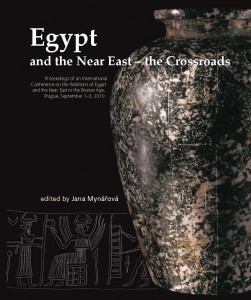 |
Jana Mynářová (ed.) Egypt and the Near East. The Crossroads Charles University in Prague, Faculty of Arts, Prague 2011 The present volume presents the proceedings from the international workshop entitled Egypt and the Near East – the Crossroads, dedicated to the study of the relations between the two regions. The symposium took place from September 1–3, 2010 at the Faculty of Arts, Charles University in Prague. The main objective of the workshop was to enhance our understanding of the historical processes and the development of the abundant and complex relations between Egypt and the Near East during the period defined by the end of the Chalcolithic Period and the dawn of the Iron Age. In light of this, special attention was given to the region of Syria-Palestine. In order to obtain a well-balanced insight, the subject was discussed both from an archaeological and from a philological point of view. The volume contains fourteen papers, all of them closely related with the topic of the workshop with seven papers based on the study of material culture and archaeological data, and seven papers devoted to the study of written sources. The first group (archaeology and material culture) contains studies devoted to the Egyptian statuary from Qatna (A. Ahrens), to material from a grown settlement of the late Middle Kingdom at Tell el-Dabca (B. Bader), an overview of results of recent excavations at Tell Tweini (J. Bretschneider / A.-S. Van Vyve / G. Jans) and Tell el-Farkha (M. Czarnowicz), a study of the predynastic Egyptian influence in the Jordanian site of Tall Hujayrat al-Ghuzlan (F. Klimscha); an essay on religious symbolism in the Southern Levant in the Bronze Age according to iconography (F. Lippke) and finally, an analysis of the Levantine combed ware from Heit el-Ghurab (A. Wodzińska / M. Ownby). As for the second group of texts (written evidence) the volume contains the following papers: a reappraisal of the tale of Wenamun in the context of Ancient Near Eastern law (Ch. Brinker), a revision of the chronology of the Amarna letters sent by Aziru, the ruler of Amurru (Cordani); a detailed revision of relations between Egypt and Ḫatti set into the context of Ancient Near Eastern chronology (E. Devecchi / J. Miller), a linguistic analysis of the terminology used to refer to the king in Egyptian and Hittite texts from Ramesside period (J. Mynářová); a study of historical topography concerning the location of the toponym Qode (Z. Simon); a reconstruction of the translation processes in the production and reception of the Amarna letters (H. Tarawneh) and finally, an analysis of the relations between Egypt, Kush and Assyria before the battle of Eltekeh (S. Zamazalová). Format: 272 x 210 mm, 350 pages, hardcover, in English. |
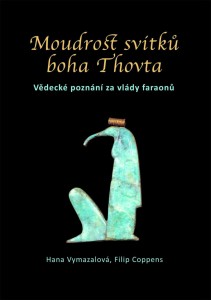 |
Hana Vymazalová – Filip Coppens Moudrost svitků boha Thovta. Vědecké poznání za vlády faraonů / The Wisdom of the Scrolls of Thoth. Scientific Knowledge in the Reign of the Pharaohs Charles University in Prague, Faculty of Arts, Prague 2011 Ancient Egyptian science developed under the patronage of the god of wisdom and writing Thoth from very early on. Scribes, priests and administrative staff composed scientific texts that helped them to fulfil their duties and preserve their knowledge for the following generations. Today only a few of these texts are known, as most of the documents written by ancient Egyptian scholars have not withstood the test of time. The present volume focuses on three specific branches of ancient Egyptian scientific knowledge: mathematics, medicine and astronomy. The book at hand not only deals with the preserved documents, but aims concomitantly to indicate and illustrate the practical use and importance of these sciences for Egyptian society. In contrast to today’s understanding of science, scientific knowledge represented in ancient Egypt a means, not a goal in its own right. It was a tool of the administrators and priests who participated in managing the country and its resources in the name of pharaoh. In essence, Egyptian scientific knowledge had a single goal: to preserve the life created by the gods and the cosmic order. Mathematics allowed for precise planning and organisation, astronomy was a means to control both space and time, while medicine preserved life itself. The great respect in which ancient scholars and authors held Egyptian scientific knowledge is apparent from the fact that they still turned to Egyptian culture for inspiration several millennia later.Format: A5, 352 pages, hardcover, in Czech. |
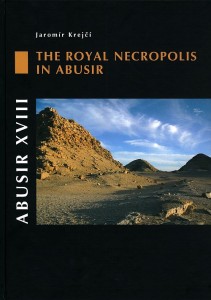 |
Jaromír Krejčí (with a contribution of Václav Cílek, Jiří Novák, Jindřich Hladil and Miloš Lang) Abusir XVIII. The Royal Necropolis in Abusir Charles University in Prague, Faculty of Arts, Prague 2010 The book is divided into sixteen chapters dealing – in a diachronic perspective – with a wide range of problems concerning the development of the royal pyramid necropolis at Abusir. The introductory sections discuss the history of research of the necropolis, the conditions for its formation, the geomorphological situation in the area, the building materials and technologies used and the historical development of the Egyptian state in the late Fourth Dynasty and the beginning of the Fifth Dynasty. The largest part of the book (chapters 8–15) is devoted to the development of the necropolis from the Archaic period until the end of the Old Kingdom. The individual chapters present and discuss buildings – particularly royal pyramid complexes – which originated during the reign of individual rulers. Attention is also paid to the sun temples and, of course, to the tombs of the royal family members and to the cemeteries of dignitaries, which were founded around the royal complexes. The final chapter summarizes the results of the research. This publication is complemented by many illustrations, which also include three-dimensional computer reconstructions of buildings which arose during the discussed period at the royal burial necropolis. Format: 223 pages, A4, hardback. Text of the book is in English. Reviews:– Michael Haase, Sokar 26/14, 2013, s. 97 |
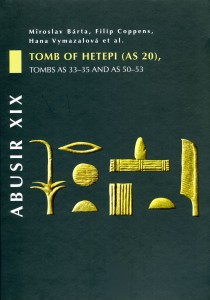 |
Miroslav Bárta – Filip Coppens – Hana Vymazalová et al. Abusir XIX. Tomb of Hetepi (AS 20), Tombs AS 33-35 and AS 50-53 Charles University in Prague, Prague 2010 The tombs published in this volume of the Abusir series have been excavated during several seasons at Abusir South. The eight tombs are located in the easternmost sector of Abusir South, on the slopes (tombs AS 20 and AS 33) and at the bottom (tombs AS 34-35, 50-53) of a large but low hill, to the north of the so-called Wadi Abusiri. They do not form a single cemetery; rather, they represent different groups of sacral structures that illustrate very well the diachronic development of the Abusir South necropolis during the Old Kingdom and the Late Period-Ptolemaic era. Most if not all of the structures document in a new way important archaeological and historical themes, such as the origin and development of the false door tradition; early administration (tomb AS 20); unique building development of early Old Kingdom tombs (AS 20 and 33); the late Old Kingdom sociology of family cemeteries (tombs AS 34-35 and 50-53) and the appearance of new Late Period animal cemeteries (tombs AS 33, 34-35 and 50-53). Format: A4, 422 pages, many b/w photos and plans, hardcover. Reviews:– Katja Weiß, Die Welt des Orients 42/2 (2012), 261–266. |
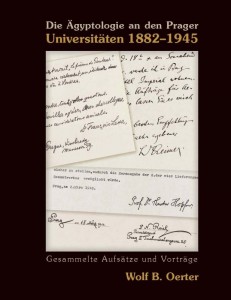 |
Wolf B. Oerter Die Ägyptologie an den Prager Universitäten 1882-1945. Gesammelte Aufsätze und Vorträge Charles University in Prague, Praha 2010 Intensive Recherchen in Universitäts- und Akademiearchiven, insbesondere im Bestand der einstigen Deutschen Universität zu Prag, brachten eine Fülle neuen Materials, neuer Einsichten und ungeahnter Zusammenhänge zutage. Sie zeigen uns die Anfänge der Ägyptologie in der Tschechischen Republik in einem völlig neuen Bild als einer Ägyptologie, die sich zunächst als böhmische artikulierte und erst später als tschechische konstituierte. Die hier von ihrem Autor, Ägyptologe und Koptologe, erstmals zusammengefassten und auf den neuesten Erkenntnisstand gebrachten Studien zur Geschichte der Ägyptologie an den Prager Universitäten aus den Jahren 1984-2007 sind zugleich ein Beitrag zur Geschichte der Karlsuniversität Prag. Reviews:– J. Pešek, ČČH 109, 2011, s. 604–605 |
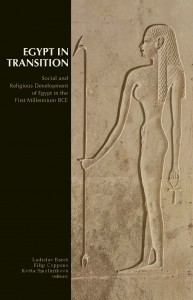 |
Ladislav Bareš – Filip Coppens – Květa Smoláriková (eds.) Egypt in Transition. Social and Religious Development of Egypt in the First Millennium BCE Charles University in Prague, Prague 2010 The first millennium BCE represents for Egypt a period of tremendous changes and developments on the political, social, economic and religious level. The millennium was shaped and characterised by a continuous interaction between Egypt as an independent political entity, with its indigenously developed social and religious system, and various political, military and cultural forces and influences introduced into the country, both through occupation and trade. Throughout the millennium one observes a conscious retrieval and interpretation of the past based on the traditions of the third and second millennium BCE in an attempt to preserve the country’s cultural identity in the face of foreign influences and occupation. As a result, new religious and social concepts developed which were incorporated in the ideological and administrative spheres of the centralised state and manifested themselves in art, architecture, language, and religion. In early September 2009, the Czech Institute of Egyptology of the Charles University in Prague hosted an international workshop dedicated specifically to social and religious developments in Egypt in the course of the first millennium BCE. The volume at hand contains twenty of the papers presented at the workshop. Format: A5, 501 pages, many b/w photographs and plans in the text, hardback. |
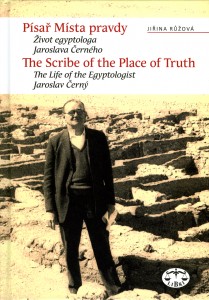 |
Jiřina Růžová The Scribe in the Place of Truth. The Life of the Egyptologist Jaroslav Černý Libri, Prague 2010 In this new biography of Jaroslav Černý the author reveals Černý in a number of different lights: his most important role was one of the world’s leading Egyptologists. He became the most famous expert in hieratic texts of the New Kingdom. He was a devoted teacher, an altruistic and constant friend to Egyptologists around the world, a loving husband and father. In England he was Professor in both the University College, London, and Oxford University. In Egypt, he participated in the excavations of the French.This biography is being published on the 40th occasion of Černý’s death, in gratitutde for all his help and advice to Czech Egyptology during his lenghty stay in England. In three major areas he has benefited his country : by his many gifts to the Czech Institute Library, by his constant support and advice to Zbynĕk Žàba, the director who was struggling to keep Czech Egyptology alive in Prague, and most importandly, by advising Czech Egyptologists to begin their excavations at Abusir. Format: A5, 15, 8 p. plates. Text in Czech and in English. |
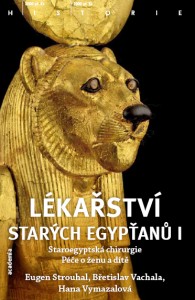 |
Eugen Strouhal – Břetislav Vachala – Hana Vymazalová Lékařství starých Egypťanů I. Staroegyptská chirurgie. Péče o ženu a dítě Academia, Prague 2010 The first of the three planned volumes dedicated to ancient Egyptian medicine contains complete translations of ancient Egyptian medical texts into the Czech language. This volume concentrates on surgical texts and texts dealing with gynecology, obstetrics and paediatrics. In addition to the translations, a detailed medical commentary is also provided, discussing the healing methods used by the ancient physicians. The texts are compared to cases of injuries and diseases detected on the ancient Egyptian mummies. Format B5, 239 pages, hardcover. |
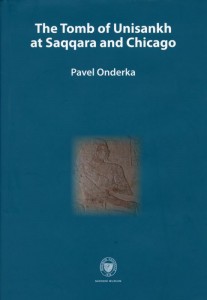 |
Pavel Onderka Tomb of Unisankh at Saqqara and Chicago Czech Institute of Egyptology, Prague 2009 Unisankh’s tomb was built within the so-called Unis Cemetery-North West, set between the funerary complexes of Netjerykhet and Unis in Central Saqqara. Together with two adjoining tombs of the viziers Ihy and Iynefert, it forms the core of the so-called Line A. The Tomb of Unisankh was discovered and excavated by James E. Quibell, then the chief inspector at Saqqara in 1908, for the purpose of the sale of its chapel to the Chicago museum. The Tomb built of Tura (or more precisely Maasara) limestone is an example of non-royal, large, multi-roomed mastabas belonging to the highest officials of the late Old Kingdom. 144 pages. |
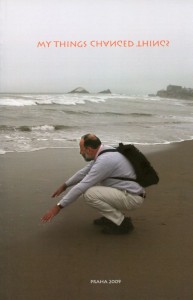 |
Petra Maříková Vlčková – Jana Mynářová – Martin Tomášek (eds.) My Things Changed Things. Social Development and Cultural Exchange in Prehistory, Antiquity and the Middle Ages Institute of Archaeology of the Academy of Sciences of the Czech Republic, Prague, v.v.i., Prague 2009 The volume contains 27 chapters focusing on the social developments and cultural aspects of contacts in Prehistory, Antiquity and the Middle Ages, extending into the modern era. 261 pages. |
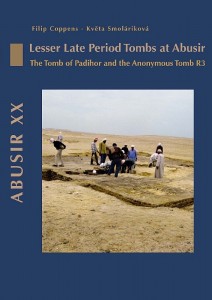 |
Filip Coppens – Květa Smoláriková Abusir XX. Lesser Late Period Tombs at Abusir. The Tomb of Padihor and the Anonymous Tomb R3 Czech Institute of Egyptology, Prague 2009 The Saite-Persian necropolis at Abusir is not only the setting for the monumental shaft tombs of dignitaries of this period, but also features a number of smaller tombs, located towards the eastern edge of the cemetery. The current study focuses on two smaller tombs – the tomb of Padihor and the anonymous tomb dubbed “R3” – whose layout and decorative program of the burial chamber provide new information on the development of the Late Period shaft tombs. Format: A4, 140 pages, paperback. |
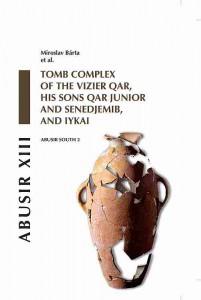 |
Miroslav Bárta et al. Abusir XIII. Tomb Complex of the Vizier Qar, His Sons Qar Junior and Senedjemib, and Iykai Dryada, Prague 2009 This is first part of publications dealing with the unique complex of the viyier Qar and his sons discovered in Abusir South between 1995-2002. Individual tombs date to the Sixth Dynasty (23rd century BC). The principal tomb belonging to vizier Qar comprised two decorated chapels in the superstructure and a burial chamber decorated as well. The tombs in the immediate vicinity belonged to his sons whose burial chambers still contained a wealth of unique items belonging to the original burial equipment. The present publication also provides a general environmental framework for the period under discussion. The following chapters may be found in the publication: 1 Introduction (M. Bárta), 2 Geology of Abusir South (C. Reeder), 3 Geophysics of Abusir South (R. Křivánek), 4 Palaeoecology of Abusir South (P. Kočár, P. Pokorný, Z. Sůvová, A. Bezděk), 5 Tomb complex of the vizier Qar (M. Bárta, with a contribution by P. Vlčková), 6 Lesser tombs of Qar’s sons: Qar Junior and Senedjemib (M. Bárta), 7 Anthropology (V. Černý, M. Kujanová), 8 Zoology (S. Ikram), 9 Conclusions (M. Bárta). Reviews:– Michael Haase, Sokar 20/11, 2010, 94 |
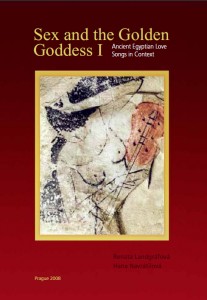 |
Renata Landgráfová – Hana Navrátilová Sex and the Golden Goddess I. Ancient Egyptian Love Songs in Context Czech Institute of Egyptology, Prague 2008 The complete collection of ancient Egyptian love songs, whose texts were first written down in the Ramesside period, is treated in the context of other period sources regarding intimacy and sexuality. The process of gendering and socialising in relation to sexuality is also introduced. The volume will also contain overview tables – ostraca or papyri, their site(s), documentation), publications, etc. Statistics or quantification of some lexical and semantic units in the songs is attempted. The volume consists of an introductory study and commented texts of the songs, grouped thematically. Format: 250 pages, b/w illus. |
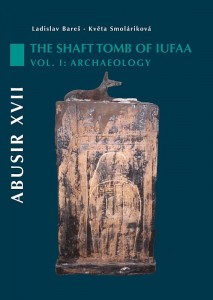 |
Ladislav Bareš – Květa Smoláriková The shaft tomb of Iufaa. Vol. I: Archaeology Czech Institute of Egyptology, Prague 2008 The first volume includes the description of the archaeological situation and finds from the main burial chamber and the place of funerary cult in front of the eastern enclosure wall of the tomb (L. Bareš), including the subsidiary burial chambers (K. Smoláriková). Separate chapters deal, among others, with the pottery (K. Smoláriková), amulets (V. Gae Callender), analysis of anthropological finds (E. Strouhal), architectural reconstruction and restoration works (M. Balík, M. Dvořák) and the Book of the Dead from the subsidiary burial chamber of Neferibreseneb Nekau (J. Janák a R. Landgráfová). The second volume is currently in preparation and will be dedicated to the texts and decoration on the walls of the burial chamber and sarcophagi of Iufaa. Format: A4, hardback. |
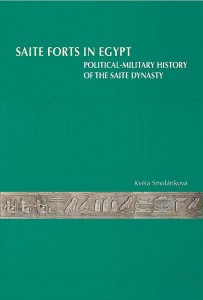 |
Květa Smoláriková Saite forts in Egypt. Political-military history of the Saite Dynasty Czech Institute of Egyptology, Prague 2008 The policy and military strategy of the Saites – the men who stayed behind the re-unification of Egypt after the period of disorder and unrest of the Third Intermediate Period is analyzed by the author in the first half of the book. The stress is put however, on the forts and various smaller types of fortifications: citadels, watchtowers, strongpoints, etc., which created the backbone of Egyptian defense system in the threatened parts of the country. Format: 160 x 240 mm, paperback, 139 pages. |
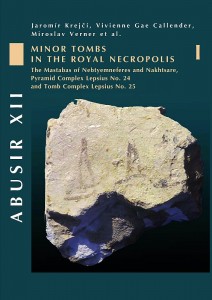 |
Jaromír Krejčí – Miroslav Verner – Vivienne Gae Callender (with contributions by Viktor Černý, Eugen Strouhal, Hana Vymazalová and Martina Žaloudková-Kujanová) Abusir XII. Minor tombs in the Royal Necropolis I. The Mastabas of Nebtyemneferes and Nakhtsare, Pyramid Complex Lepsius no. 24 and Tomb Complex Lepsius no. 25 Czech Institute of Egyptology, Prague 2008 This monograph presents a report on the results of the archaeological excavations of the Czech Institute of Egyptology undertaken from 1987 until 2004 and held in the area of the Abusir minor tombs clustered around the tombs of the 5th Dynasty kings. The first chapter isdevoted to the excavation and description of the mastaba of Nebtyemneferes, a rather enigmatic identity – probably a princess – who was buried among the tombs of the members of the royal family in the southern part of the Abusir pyramid necropolis. The tomb includescommon features of Abusir tombs of the period.The second chapter deals with research into the mastaba of Prince Nakhtsare, located to the south of Raneferef’s mortuary temple; it is the northernmost tomb in a row of tombs located on the southern border of the royal necropolis.The important position of this very destroyed tomb is also indicated by its rich burial equipment, as well as by the masons’ marks found on the masonry of the mastaba. The third chapter is devoted to the pyramid complex of an unknown queen in a tomb known as Lepsius no. 24. Because a large number of masons’ marks was present on this pyramid’s walls, and, in addition, because of the bad state of preservation of this monument, we have been able to study in an unique way the methods used by the ancient architects and builders in the construction of royal monuments in the middle of the Fifth Dynasty. A further chapter is dedicated to a most exceptional complex – the monument known to us now as Lepsius no. 25. This monument represents a double tomb whose name was written as double pyramid. Unfortunately, it is in a very desolated state of preservation, so much so that many details of its intriguing architecture as well as the burial equipments, etc., have been lost to us forever. The sixth chapter is devoted to the anthropological material discovered during the archaeological excavations of these monuments. The majority of this material is represented by remains coming from the Late Period cemeteries, which once covered this area. In addition to this fairly large group, there is one very significant study featuring the fragments of a female mummy which might have belonged to the owner of the pyramid complex Lepsius no. 24. A study of the stone vessels found in the monuments discussed in this monograph represents an Appendix. Format: A4, hardback. Reviews:– Michael Haase, Sokar 23/12, 2011, s. 96 |
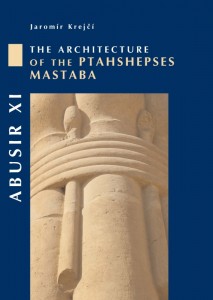 |
Jaromír Krejčí Abusir XI. The Architecture of the Mastaba of Ptahshepses Czech Institute of Egyptology – Academia, Prague 2008 The text consists of six chapters dealing with the history of exploration, with the tomb owner – Vizier Ptahshepses – his social status and his role within the royal court as well as with other members of his family, with the location of the mastaba in the frames of the Abusir Royal Necropolis. The largest part of the monograph is represented by the fourth chapter, which is dedicated to the description of the individual building stages of the mastaba. Besides the description of the remaining masonry and the architectural elements, possible reconstructions of the original appearance of the mastaba’s respective parts are presented as well. The fifth chapter (Remarks on the architecture and function of the mastaba) emphasises some features of the mastaba’s architecture which are discussed in the broader context of the development of ancient Egyptian architecture during the Third Millennium B.C. This chapter also includes a discussion on the spatial and functional analysis of the mastaba. The sixth, concluding chapter, sums up the previously mentioned topics and the place of the tomb and its owner in the framework of the development of the Old Kingdom. It is also devoted to an analysis of the dating of the mastaba’s construction. Format: A4, hardback. Reviews:– Michael Haase, Sokar 21/11, 2010, s. 94 |
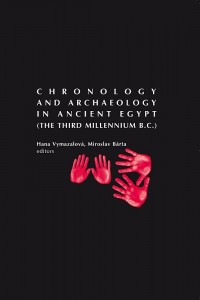 |
Hana Vymazalová – Miroslav Bárta (eds.) Chronology and Archaeology in Ancient Egypt (The Third Millennium B.C.) Czech Institute of Egyptology, Prague 2008 The nineteen contributions to this volume approach the subject of Egyptian chronology from different perspectives: some of them concern the use of modern methods (14C) and natural sciences in Egyptology; others analyze the development of various aspects of the Egyptian culture during the whole period of the Old Kingdom and the First Intermediate Period, or try to specify the date of certain monuments and personalities. A study and interpretation of archaeological as well as textual sources and iconographical material is combined in the papers in order to attain a deeper knowledge and better understanding of the Egyptian chronology, archaeology and the ancient history. Contributions by: Hartwig Altenmüller, Tarek El Awady, Miroslav Bárta, Aleš Bezděk, Vivienne Gae Callender, Andrzej Ćwiek, Michael Dee, Mohamed Ismail Khaled, Jaromír Krejčí, Juan Carlos Moreno García, John S. Nolan, Hratch Papazian, Patrizia Piacentini, Christopher Bronk Ramsey, Joanne M. Rowland, Teodozja Rzeuska, Anthony Spalinger, Rainer Stadelmann, Miroslav Verner, Hana Vymazalová, Anna Wodzińska. Format: B5, hardback, 265 pages. |
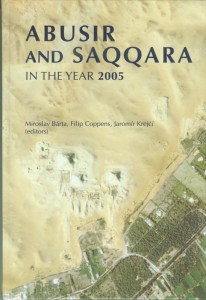 |
Miroslav Bárta – Filip Coppens – Jaromír Krejčí (eds.) Abusir and Saqqara in the Year 2005. Proceedings of the Conference Held in Prague (June 27–July 5, 2005) Czech Institute of Egyptology, Prague 2008 The present volume is the result of the second international symposium dedicated to the necropolis of Abusir, Saqqara and Dahshur that took place in Prague in June–July 2005. The thirty articles include contributions by Hartwig Altenmueller, Dieter Arnold, Vassil Dobrev, Ludwig Morenz, Miroslav Verner, Christiane Ziegler and numerous other scholars. The contributions cover various aspects of the Memphite region from the Early Dynastic Period to the Roman era, but the bulk of the papers focus on the Abusir–Saqqara necropolis in the Old Kingdom. A study and interpretation of the archaeological remains and literary sources form the main themes of interest among the contributions, but the most characteristic feature of most papers is the use of a combination of archaeological, literary and iconographic material in order to attain a deeper knowledge and better understanding of the Memphite necropolis and its development over time. Format: B5 hardback, 438 pages, and 24 plates. The volume can be ordered through Megabooks ( orders@megabooks.cz) or OXBOW. Reviews:– A. Zivie, Bibliotheca Orientalis 5–6/LXX, 2013, 645–648 |
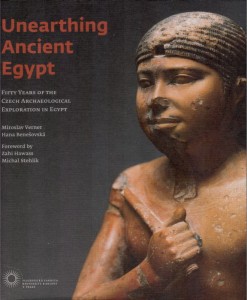 |
Miroslav Verner – Hana Benešovská Unearthing Ancient Egypt. Fifty Years of the Czech Archaeological Exploration in Egypt Togga – Faculty of Arts, Charles University in Prague, Prague 2008 This richly illustrated representative publication celebrates the 50th anniversary of the foundation of the Czech Institute of Egyptology and presents an overview of the history and work of the Institute over the entire period of its existence. The partner of the celebrations of the 50th anniversary of the Czech Institute of Egyptology is ČD CARGO, a. s. Reviews:– J. Malek, Bibliotheca Orientalis LXIX 5/6, 2012, s. 436–439 |
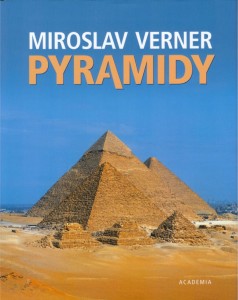 |
Miroslav Verner Pyramidy Academia, Prague 2008 The book contains a complete overview of all pyramids that have hitherto been discovered in Egypt, and deals with the period when they were built as well as with the researchers who have taken part in their exploration. The book was published first in 1996 and was translated into several languages. Since that time, many new discoveries were made and many new theories appeared, and the second Czech edition thus reflects the state of the art at the beginning of the 21st century. Text in Czech. |
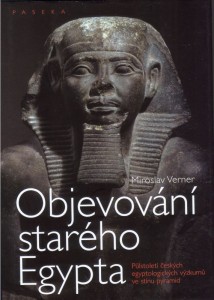 |
Miroslav Verner Objevování starého Egypta Paseka, Prague 2008 This mongraph is dedicated to the discovering of archaeological treasures in the land of the pharaohs, to the fifty years of effort of Czech Egyptologists, archaeologists and other founders of the glory of Czech Egyptology. It looks back at the uneasy beginnings of the Czech Institute of Egyptology. Above all, however, it deals with the fifty years of Czech archaeological excavations in Egypt and the newest exploration of Czech Egyptologists in the Western Desert. Text in Czech. |
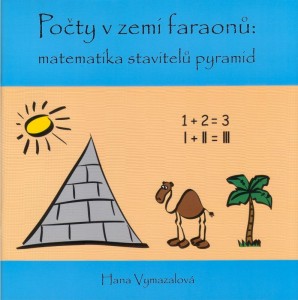 |
Hana Vymazalová Counting in the Land of the Pharaohs. Mathematics of the Pyramid Builders Dokořán, Prague 2008 Egyptian scribe Nefer teaches his sister Seshen – and all curious children – how to count. Text in Czech. |
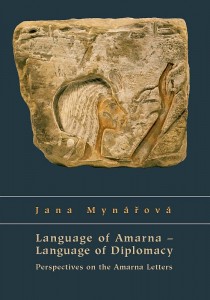 |
Jana Mynářová Language of Amarna – Language of Diplomacy. Perspectives on the Amarna Letters Czech Institute of Egyptology, Prague 2007 It is a generally accepted presumption that during the Late Bronze Age the language accepted for the ‘international’ or ‘diplomatic’ written communication between the representatives or members of the particular polities within the Ancient Near East was Akkadian, or more accurately Peripheral Akkadian. Thus it is the aim of this publication to analyze the corpus of Amarna letters on the subject of diplomatic terminology and procedures. Format: B5, 288 pages, hardback. |
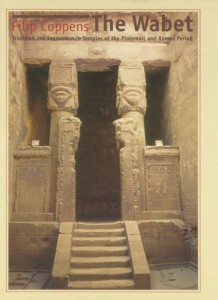 |
Filip Coppens The Wabet. Tradition and Innovation in Temples of the Ptolemaic and Roman Period Czech Institute of Egyptology, Prague 2007 The volume provides an in–depth study of an architectural ensemble that consists of an open court and elevated chapel, better known as the wabet, and forms an essential part of the layout of a dozen temples in Egypt of the Thirtieth Dynasty and the Ptolemaic and Roman era (e.g Philae, Edfu, Dendara, Shanhûr, and Deir Shalwît). The volume focuses on the ensemble’s location, orientation, and layout, the designations in use to refer to the complex, and the decorative scheme applied to its walls in order to gain a better insight into the activities performed in the complex and its role within the temple. The volume also takes a closer look at various plausible precursors of the complex in temples of the New Kingdom and the Late Period and examines the ensemble’s relation to the wabet as a ‘place of embalming’.Format: 245 pages, 39 illustrations (20 plans, 19 b/w photographs) and 12 tables, hardback, 19 x 25 cm. |
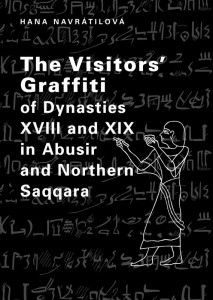 |
Hana Navrátilová The Visitors’ Graffiti of Dynasties XVIII and XIX in Abusir and Saqqara Set Out – Czech Institute of Egyptology, Prague 2007 This is the first volume of an intended series on visitors’ graffiti. It deals with the visitors’ graffiti from Abusir (monuments of the 5th Dynasty) and Northern Saqqara (the pyramid complex of Djoser). It contains a catalogue of graffiti, and interpretative essays on the authors, contents and possible meaning of these often quoted, but underestimated texts. This volume will offer the first complete publication of graffiti documented by B Gunn in Djoser’s complex. 300 pages, col and b/w illus t/out, CD (The Visitors’ Graffiti 1, Czech Institute of Egyptology 2008). Access to the archive material was kindly granted by the Griffith Institute. |
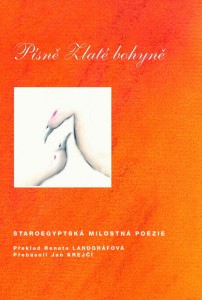 |
Renata Landgráfová, introduction by Hana Navrátilová, poems by Jan Krejčí Písně Zlaté bohyně. Staroegyptská milostná poezie / Songs of the Golden Goddess. Ancient Egyptian Love Poetry Set Out – Czech Institute of Egyptology, Prague 2007 This volume contains translations and commentaries of all hitherto known ancioent Egyptian love songs. Some of them, above all the songs contained in larger “collections”, were translated to several world languages and are well-known to the Egyptological public. These songs appear in the beginning of the book. Some of the other songs, that appear individually on ostraca, have hitherto received only inadequate attention or none at all, and the present volume represents the most complete collection of ancinet Egyptian love songs even in international context. The book is complemented by a CD with poems and music. Text in Czech. The book was published with the support of the company UNIS. |
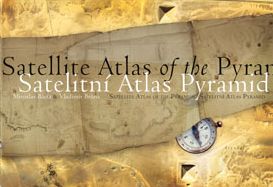 |
Miroslav Bárta – Vladimír Brůna Satellite Atlas of the Pyramids Dryáda – Czech Institute of Egyptology, Prague 2007 The book Satellite Atlas of the Pyramids presents satellite images of the most famous pyramid fields of ancient Egypt of the time of the pyramid builders. For the first time it presents satellite images of tombs and cemeteries of ancient Egyptian kings to Czech and international public, using the highest resolution possible.The examined area includes, from north to south, the sun temple of Abu Ghurab and the pyramid necropoleis of Abusir, Saqqara and Dahshur. These sites hold the vast majority of all known pyramids of Old Kingdom kings (and include also several Middle Kingdom pyramids at Dahshur) and hundreds of tombs of high and lesser officials of their time. The publication includes also texts relating the history of the mapping of the area and reproductions of maps that were gradually created since the time of Napoleon’s expedition to Egypt at the end of the 18th century until the present.The publication contains 3 folded large-format maps printed on the largest offset machine in the world (the maps at 192 cm long); a satellite image in full resolution, Lepsuis’ map (which has never been published as a whole and the only painted original of which is located in Berlin) and de Morgan’s map (which has also never been published as a whole). |
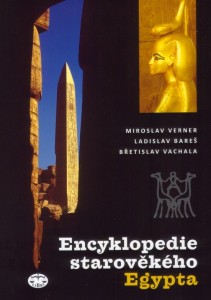 |
Miroslav Verner – Ladislav Bareš – Břetislav Vachala Encyklopedie starověkého Egypta / Encyclopaedia of Ancient Egypt Libri, Prague 2007 The most important Czech Egyptologists, who have for several decades taken part at yearly archaeological campaigns above all at Abusir, authored hundreds of accessible and interesting entries presenting the current level of knowledge about the unique, and despite the explorations still mysterious ancient Egyptian civilization. This is a revised edition of the book that was published in 1996, but due to its high price was practically inaccessible for the Czech public. This time, the texts is accompanied above all by line drawings and black-and-white illustrations. Text in Czech. |
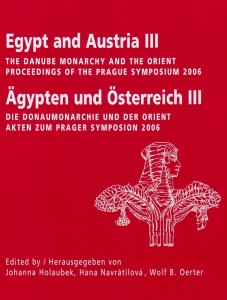 |
Johanna Holaubek – Hana Navrátilová – Wolf B. Oerter (eds.) Egypt and Austria III. The Danube Monarchy and the Orient. Proceedings of the Prague Symposium 2006 Czech Institute of Egyptology, Prague 2007 This book is the published proceedings of the workshop organised by the Czech Institute of Egyptology, Czech Academy of Sciences and Institute of Egyptology, University of Vienna. Papers deal with many topics, including the presence of Europeans, especially people from the former Hapsburg monarchy, in Egypt, but also of Egyptians and people of Middle Eastern origin in Central and Eastern Europe. Special attention is paid to scholarly travel and expeditions. The history of travel in Egypt is also addressed, as well as politics, art history and cultural history. A selection of papers deal with special aspects of Egyptomania, such as the presence of Egypt in European funerary art, the impact of Egypt in Renaissance culture, or the presence of Egypt in education. Two exceptional contributions by A Lant (on sphinxes in silent cinema) and by J Janák (the Austrian ibises) bring new perspectives to our perception of relations between the West and the East. |
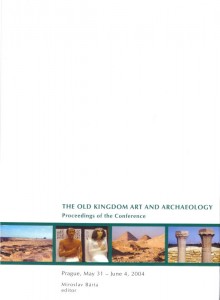 |
Miroslav Bárta (ed.) Old Kingdom Art and Archaeology. Proceedings of the conference, Prague 2004 Czech Institute of Egyptology, Prague 2006 During 2004 a conference dedicated to the history, art, archaeology and language of the Old Kingdom Egypt (2700 – 2200 B.C.) was organised by the Czech Institute of Egyptology in Prague. The forthcoming publication makes available a representative overview of the latest research and trends presented by more then thirty Egyptologists, most of them leading experts in their respective fields of specialisation. Published with financial support of Michela Schiff Giorgini grant. |
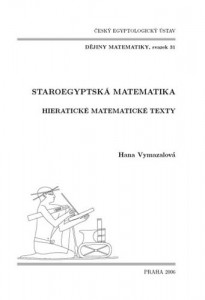 |
Hana Vymazalová Ancient Egyptian Mathematics. Hieratic mathematical texts Czech Institute of Egyptology, Prague 2006 This book deals with ancient Egyptian mathematics on the basis of preserved mathematical texts. Most of them served for teaching mathematics in the Egyptian scribal schools, and thus they offer us a glimpse not only at mathematics as such, but also on some of the methods that were used in the education of future state officials. The first part of the book contains a basic overview of the contents of the preserved texts, presents the scope of the problems solved in them and the differences between examples coming from various texts. The second part is formed by translations of hieratic mathematical texts, which include, besides the most famous Rhind mathematical papyrus also the Moscow papyrus, Kahun fragments, wooden tablets from Akhmim, the Berlin museum fragments, and the London leather roll. Text in Czech. |
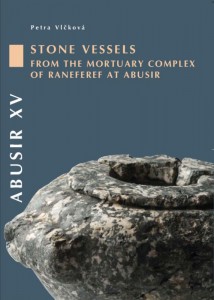 |
Petra Vlčková Abusir XV. Stone Vessels from the Mortuary Complex of Raneferef at Abusir Czech Institute of Egyptology, Prague 2006 The assemblage of stone vessels belongs to the extensive archaeological material brought to light during the excavations conducted by the Czech Institute of Egyptology in the mortuary complex of king Raneferef (5th Dynasty) at Abusir. Raneferef’s assemblage represents a unique archaeological complex where the artefacts are complemented with their recorded archaeological context (structure, site, etc). The monograph includes the analysis of the assemblage of stone vessels by its material characteristics. |
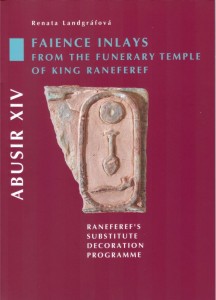 |
Renata Landgráfová Abusir XIV. Faience Inlays from the Funerary Temple of King Raneferef Czech Institute of Egyptology, Prague 2006 In the course of the exploration of the funerary temple of King Raneferef, the expedition of the Czech Institute of Egyptology discovered about 2000 fragments of faience inlays and tablets of Egyptian blue bearing texts and scenes in relief. The present volume contains the full description, analysis and interpretation of this unique find. The evidence, analysed by the author in archaeological and historical context, suggests that the inlays (and probably also the tablets of Egyptian blue) had once decorated wooden shrines containing the statues of the king, and the functional analysis of their motifs indicates that the inlays and tablets in all likelihood formed a substitute of the relief decoration that was missing in the temple of Raneferef. The volume contains a separate chapter with the mineralogical analysis of several samples of both faience and Egyptian blue, studied in transmitted light using the Axiolab microscope, and on the microprobe Cameca SX 100 at the Department of geological sciences, Masaryk University Brno. |
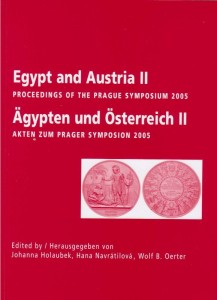 |
Johanna Holaubek – Wolf B. Oerter – Hana Navrátilová (eds.) Egypt and Austria II. Proceedings of a Symposium Czech Institute of Egyptology, Prague 2006 This is the second collection of proceedings from the workshop of the Austrian and Czech Egyptologists and historians. The contributions are connected by the theme of Egyptomania, and the use of Ancient Egypt as an inspirational source to modern art. |
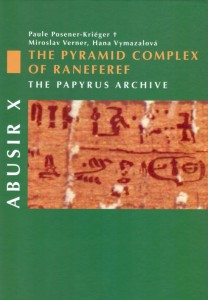 |
Paule Posener-Kriéger – Miroslav Verner – Hana Vymazalová Abusir X. The Pyramid Complex of Raneferef. The Papyrus Archive Czech Institute of Egyptology, Prague 2007 This volume of the Abusir series of monographs is dedicated to the editionof the papyri found in the mortuary temple of Raneferef. The edition alsoinvolves the interpretation of the papyri and detailed relevant studies onthe chronology, place names, temple personnel, the temple economy, theaccounting terminology, and the woven materials. Besides the palaeographicplates, also appended to the volume are detailed indices, glossaries and alist of the references. |
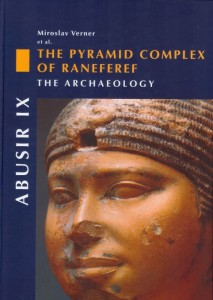 |
Miroslav Verner et al. Abusir IX. The Pyramid Complex of Raneferef. The Archaeology Czech Institute of Egyptology, Prague 2006 The main archaeological results of the excavation of the pyramid complex of Neferre in Abusir are published in this report. This volume deals primarily with the archaeological examination of the monuments of the complex.Chapters on the structural analysis of Raneferef’s mortuary temple, the chronology of the complex and the shape and meaning of the pyramid in the Old Kingdom complement the archaeology. Also discussed are: the builders’marks and inscriptions, seals and sealing, jar dockets, pottery, statues, amulets and beads, faience inlays and tablets of Egyptian blue, anthropological remains of Raneferef, stone vessels, chipped lithics and micro-wear analysis of chert. There is also a chapter on the mud-brick masonry of the mortuary temple. |
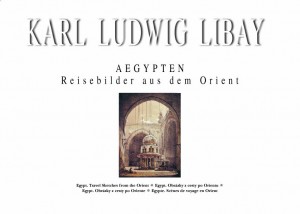 |
Dušan Magdolen – Lucie Storchová (eds.) Egypt. Travel sketches from the Orient Set Out, Prague 2006 Album of lithographs by Karl Ludwig Libay, accompanied with the text by Alfred von Kremer.The modern edition of a classical richly illustrated „picture travelogue“ of an Austrian painter. Karl L. Libay was a prominent vedutiste. He visited Egypt in 1850s and completed there a remarkable set of aquarel paintings, later transposed into lithographs. The lithographs are accompanied with a text by a prominent Austrian scholar of that time, Alfred von Kremer, later the Austrian deputy in the powers’ committee governing the Egyptian state debt in the late 1870s. The lively scenes are in part corresponding to the contemporary vogue represented e.g. by David Roberts, but in part they have an original setting and mise-en-scéne. The text is a unique testimony to the period vision of Egypt, her history and especially her inhabitants. Some Oriental stereotypes are mixed with genuine scholarship, the text aimed in its time at a broad audience and the tendency to attract various readers makes it a fascinating reading even today. The book contains colour reproductions of the complete set of lithographs as once published in 1858, and the original German and French text by Kremer, accompanied by the English, Czech and Slovak translation (Libay was born in that part of former Hungary which is now Slovakia) and commentary. Dr. Dušan Magdolen, Egyptologist, is fellow of the Slovak Academy of Sciences in Bratislava, Dr. Lucie Storchová, historian, is now Researcher at the Charles University in Prague, Faculty of Social Sciences; both editors are affiliated to the research team of the Czech Institute of Egyptology. The book was published with the support of the company UNIS. |
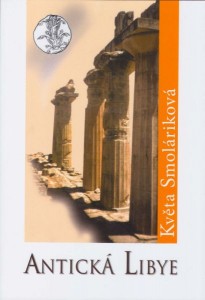 |
Květa Smoláriková Antická Libye / Ancient Libya FOTO-GRAFIKA, Brandýs n/L. 2006 The richly illustrated book guides the readers through all important cities of Classical Antiquity lying on the Libyan coast of the Mediterranean sea, such as Cyrene, Apollonia, Ptolemais, etc. The placement of these cities on the apparently uninviting coast confirms the great experience of ancient Greeks and Phoenicians, who were founding new trade stations on places rich in raw materials. Many of these cities have for several centuries kept a status comparable to that of the greatest cities of the empire.The author has travelled the Libyan coast herself, and the book is conceived also as an invitation to a visit of the ancient beauties of Libya. Text in Czech. |
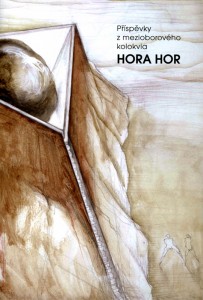 |
Tomáš Mařík – Jana Maříková-Kubková (eds.) Hora hor. Sborník příspěvků přednesených na konferenci uspořádané u příležitosti výstavy Aleše Veselého na téma „Hora hor“ Archeologický ústav AV ČR, v.v.i., with support of Nadace Židovského muzea v Praze and Univerzita Karlova v Praze, Filozofická fakulta, České národní egyptologické centrum, Praha 2005 The volume consists of ten papers read during the interdisciplinary colloquium held on the occasion of the exhibition “Mountain of Mountains” of the Czech artist Aleš Veselý. This exhibition was organized by the Jewish Museum in Prague in 2003. The individual papers concern various aspects of the (sacred) mountain as they appear in the culture of ancient Egypt, Syria, Mesopotamia, Palestine, Greece, China and also in pre-Columbian societies of Mesoamerica. These aspects has been studied from perspectives of archaeology, history of art, religious studies and general history. Text in Czech. |
 |
Jiří Janák Doors of Heaven. Gods and demons of ancient Egypt Libri, Prague 2005 This book presents the general public with a long awaited overview of ancient Egyptian religion. It is divided into two sections. The first contains an introduction and introduces the reader to the ancient Egyptian concept of divinity. The second part contains an alphabetically ordered lexicon of deities. Text in Czech. |
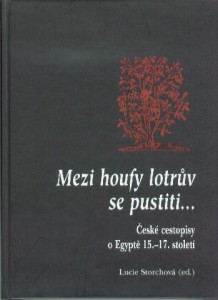 |
Lucie Storchová (ed.) To plunge among the hordes of scoundrels. Czech travelogues about Egypt of the 15th – 17th centuries Set Out, Prague 2005 The project of a three-volume commented anthology of Czech travelogues about the Orient, of which this book is the first part, is intended to provide access to an interesting collection of sources for the study of Czech travelling. Some of the sources that will be published in terms of this edition, have already been published before, but mostly in the 19th century, and a re-edition in terms of modern editorial practices is much needed (this is the case of Harant’s journey or of the travelogue of Martin Kabátník). Others exist only in the form of the original publications (the texts of J. Žvejkal, V. Foit, or H. Mayer). The last group is formed by hitherto unpublished manuscript materials (eg. P. Dušková – correspondence or part of the correspondence of B. Hrozný and F. Lexa). The individual anthologies will be conceived as representative selections, this limited edition cannot cover all the relevant material. This is true above all for the most recent times. The first volume is dedicated to the travelogues of the 16th and early 17th centuries, of the authors Martin Kabátník, Bohuslav Hasištejnský of Lobkowitz, Kryštof Fictum of Fictum and above all Kryštof Harant of Polžice and Bezdružice. Text in Czech. |
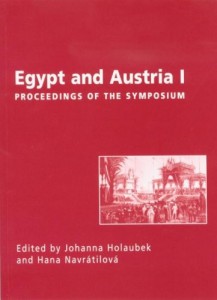 |
Johanna Holaubek – Hana Navrátilová (eds.) Egypt and Austria I. Proceedings of the symposium Set Out, Prague 2005 This volume is dedicated to the relationships between the Hapsburg monarchy and Egypt set in their historical context. It contains contributions about the interests of travelers in the 16th – 20th centuries and the cultural interests of artists and collectors in the land on the Nile. available, contact distributors |
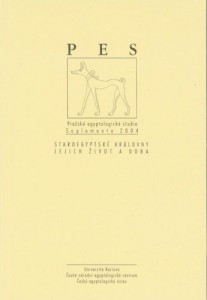 |
Hana Vymazalová (ed.) Prague Egyptological Studies, suplementa 2004. Ancient Egyptian Queens, Their Life and Time Charles University in Prague, Czech National Centre for Egyptology and Czech Institute of Egyptology, Prague 2005 This volume represents the supplement of the main periodical Prague Egyptological Studies. It contains a series of articles devoted to the queens of ancient Egypt, their life, status, time in which they lived, and the heritage they left behind. Most of the contributions are based on the lecture cycle “Prague Egyptological Spring 2004 – Ancient Egyptian Queens”, which was held in the spring of 2004 at the Náprstek Museum of Asian, African and American Cultures. Text in Czech. PDFs available here |
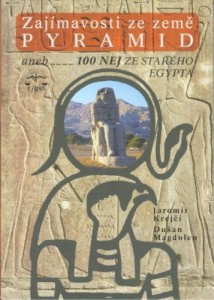 |
Jaromír Krejčí – Dušan Magdolen Interesting Glimpses into the Land of the Pyramids or 100 MOSTs of Ancient Egypt Libri, Prague 2005 The entries of the book of J. Krejčí and D. Magdolen are dedicated to introducing the individual aspects of Ancient Egyptian civilization and the decisive moments of its study in the unique form of a list of various superlatives from the area of history, archaeology, architecture, religion, literature, arts, crafts, historiography, etc. The world of the ancient Egyptians has always attracted a great interest for the high level of its culture, knowledge of the surrounding world, large buildings, and their fascination by the sacred and by the hereafter. The book is accompanied by a glossary of terms and a large bibliography on ancient Egypt. Its aim is to stimulate both the interest in Egyptology as a scholarly discipline, but also in the development of human civilization and culture as a whole. Text in Czech. |
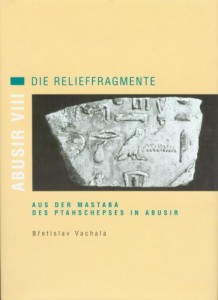 |
Břetislav Vachala Abusir VIII. Die Reliefs aus der Ptahschepses-Mastaba in Abusir Charles University in Prague, Czech Institute of Egyptology, Prague 2004 This volume of the Abusir series is dedicated to the publication of the relief fragments from one of the largest and best known non-royal tombs from the Saqqara area – the mastaba of vizier Ptahshepses. The numerous fragments from the mastaba are arranged into thematic groups and analysed. Text in German. last copies (OXBOW only) |
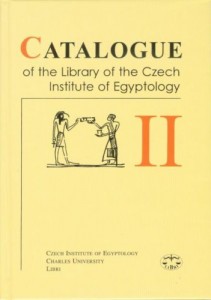 |
Jiřina Růžová Catalogue of the Library of the Czech Institute of Egyptology, vol. 2 Czech Institute of Egyptology, Prague 2004 The second volume of the library catalogue, covering chiefly the sections on Archaeology and Philology. The Catalogue covers the library fund from the beginning of the existence of the Prague Egyptological seminar, through the enlargement due to Jaroslav Černý’s donation in the 1970s, and ends with new acquisitions up to year 2000. available, contact distributors |
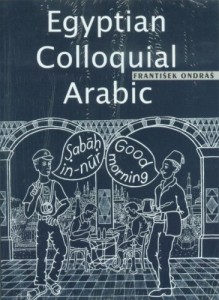 |
František Ondráš Egyptian Colloquial Arabic Czech Institute of Egyptology – Set Out, Prague 2004 This textbook introduces the reader to the spoken language of Egypt. It is designed to lead the reader on a journey through Egypt, with each chapter introducing new situations, and provides an introduction to many aspects of modern Egyptian culture and life. Beginning with the arrival in the country, each chapter offers the reader examples of everyday phrasal usage and thorough explanations of Arabic grammar. More than a phrasebook and a dictionary, this book is a useful tool for learning the Egyptian Colloquial combining handy explanations with a systematic approach to the grammatical structure of the language. available, contact distributors |
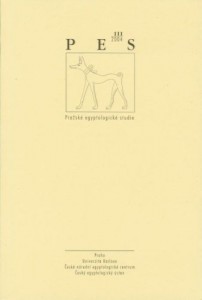 |
Jana Mynářová (ed.) Prague Egyptological Studies (PES) 3 Charles University in Prague, Czech National Centre for Egyptology and Czech Institute of Egyptology, Prague 2004 The third volume of the educative yearbook, containing an overview of the most recent discoveries and interesting themes in Egyptology, and introducing new Czech excavations in Egypt. The text is accompanied by black-and-white illustrations and photographs. Text in Czech. PDFs available here |
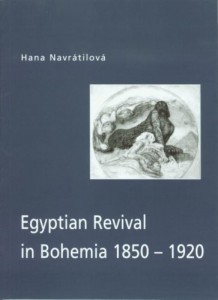 |
Hana Navrátilová (with a contribution of R. Míšek) Egyptian Revival in Bohemia Set Out – Czech Institute of Egyptology, Prague 2003 Subtitled ‘Orientalism and Egyptomania in Czech Lands’, this study looks at Egyptian revival in the second half of the 19th century within Czech society. Asking who these Egyptomaniacs were and why they chose Egypt, Hana Navrátilová looks at the historical and cultural background of the period, arguing that Egyptian revivalism was important for both Czech cultural development and the formation of national identity. available, contact distributors |
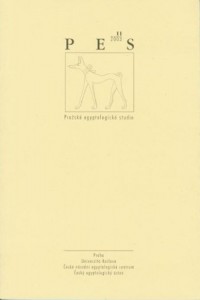 |
Jana Mynářová (ed.) Prague Egyptological Studies (PES) 2 Charles University in Prague, Czech National Centre for Egyptology and Czech Institute of Egyptology, Prague 2003 This volume of the yearbook is traditionally divided into two thematic groups. While one part is dedicated to archaeological reports from the most recent Czech excavations at Abusir, the other brings various studies covering the whole field of modern Egyptology. Text in Czech. PDFs available here |
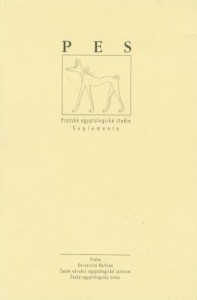 |
Hana Vymazalová (ed.) Prague Egyptological Studies (PES), suplementa 1 Charles University in Prague, Czech National Centre for Egyptology and Czech Institute of Egyptology, Prague 2003 The publication of the first volume of the supplements to the Prague Egyptological Studies was stimulated by the success of the lecture series “Éminences grises of ancient Egyptian history,” which was realized in cooperation with the Náprstek Museum in the spring of 2003. The individual authors introduce both the interesting lives of the various personalities, but also their period, changes of the economic and political conditions of the Egyptian state, development of art, etc. Text in Czech. PDFs available here |
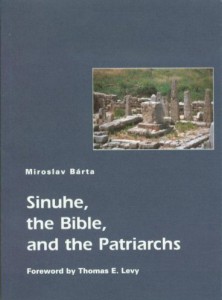 |
Miroslav Bárta Sinuhe, Patriarchs, and the Bible Czech Institute of Egyptology – Set Out, Prague 2003 The legendary figure of Sinuhe, an Egyptian administrator who fled Egypt upon the assassination of the king later to return without reprisals, is preserved in the Tales of Sinuhe found on a number of papyri and ostraca. This study not only includes a translation of the Tale, with commentary, but goes further to explore the historical and political context in which it was written in Middle Kingdom Egypt. Arguing that there is no evidence to suggest that Sinuhe was ever a real historical figure, Bárta presents evidence for Sinuhe being a fictitious character, a piece of political propaganda set in an idealized society. Beyond the Tale itself, Bárta examines a wide range of Egyptian documents and archaeological evidence from Egypt and the Southern Levant from the early 2nd millennium BC. available, contact distributors |
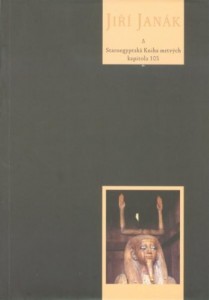 |
Jiří Janák The Ancient Egyptian Book of the Dead, Chapter 105 Pontes Pragenses 29, L. Marek, Brno 2003 This volume introduces the readers to the various aspects of ancient Egyptian religion. The volume is mostly dedicated to Chapter 105 of the Book of the Dead, but the reader will also find a lot of information about the ways of thinking of the ancient Egyptians, their burial customs and other ancient Egyptian funerary texts. Text in Czech. |
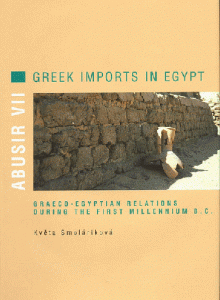 |
Květa Smoláriková Abusir VII. Greek Imports in Egypt. Graeco-Egyptian Relations During the First Millennium B.C. Charles University in Prague, Czech Institute of Egyptology, Prague 2002 The early Greek residents to arrive in Egypt were very much regarded as foreigners and were subject to all sort of restrictions, however, gradually the barriers were broken down as closer connections were established with the Greek mainland and new trading centres such as Naucratis were established. This volume studies the large amount of Greek imported pottery found in Egypt and assesses what the pottery can tell us about the Greek-Egyptian relationships, Greek settlement in Egypt, and the nature of this trade. available, contact distributors |
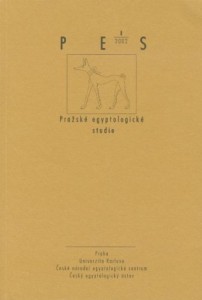 |
Jana Mynářová (ed.) Prague Egyptological Studies (PES) 1 Charles University in Prague, Faculty of Arts – Set Out, Prague 2002 The first volume of an educative yearbook brings an overview of the most recent discoveries and interesting themes in the field of Egyptology, and informs readers about new Czech excavations in Egypt. The text includes a number of line drawings and photographs. Text in Czech. PDFs available here |
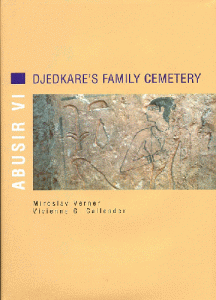 |
Miroslav Verner – Vivienne G. Callender Abusir VI. Djedkare’s Family Cemetery Czech Institute of Egyptology – Set Out, Prague 2002 This volume contains the results of excavations at the Djedkare’s family cemetery at Abusir, arranged by individual tomb. Verner and Callender describe the structure and archaeology of the tomb including plans of the rooms, its owner, wall paintings and finds from the tomb. These chapters are succeeded by a discussion of the chronology of the tombs, a typology and details on the skeletal remains. Appendices look at the role of female members of the Djedkare family in the old Kingdom. available, contact distributors PDF available from Electronic publications |
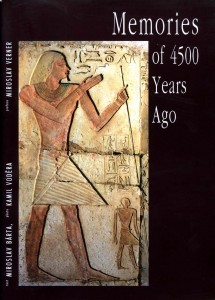 |
Miroslav Bárta (text) – Kamil Voděra (photography) Memories of 4500 years ago Foto-Grafika Kamil Voděra, Brandýs nad Labem 2002 A guide to the exhibition dedicated to new discoveries of Czech Egyptologists in South Abusir, in the family tomb complex of vizier Qar and judge Inti. Czech and English versions. PDF available from Electronic publications |
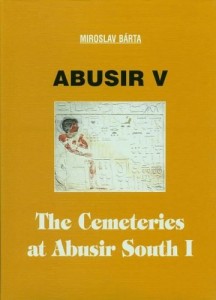 |
Miroslav Bárta Abusir V. The Cemeteries at Abusir South I Set Out – the Czech Institute of Egyptology, Prague 2001 This report describes work carried out between 1991 and 1993 on a number of Old Kingdom tombs, mostly of lesser officials. Each tomb is given a full treatment with archaeology, architecture, decoration, epigraphic descriptions and a catalogue of significant finds, with the exception of pottery, which will be published separately. The volume is illustrated with line drawings. Contents: The tomb of Ity; the Lake of Abusir tombs; the tomb of Fetekty and adjacent tomb complexes; the tomb of Kaaper; some taphonomic, demographic and pathologic aspects of the skeletons from mastaba tombs at Abusir South; Palaeographic table; Indexes: Royal names, non-royal names, titles and epithets, gods, tombs. last copies (OXBOW only) PDF available from Electronic publications |
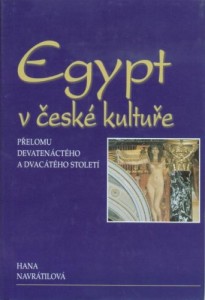 |
Hana Navrátilová Egypt v české kultuře přelomu devatenáctého a dvacátého století Set-Out, Prague 2001 Czech original of The Egyptian Revival in Bohemia. |
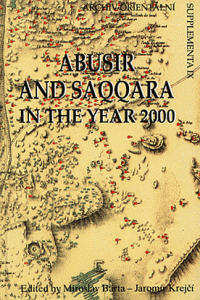 |
Miroslav Bárta – Jaromír Krejčí (eds.) Abusir & Saqqara in the Year 2000 Academy of Sciences of the Czech Republic, Oriental Institute, Prague 2000 This collection of articles contains the basic survey of the works that have been realized in the Abusir-Saqqara area in the course of the last fifty years. The book is arranged into several sections: varia, Islamic, Coptic and Late Periods, the New Kingdom and the Second Intermediate Period, the Middle Kingdom and the First Intermediate Period, and the Old Kingdom and the Archaic Period. out of print, reprint considered very last copies (OXBOW only) PDF available from Electronic publications |
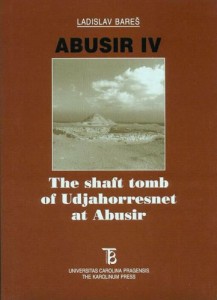 |
Ladislav Bareš Abusir IV. The Shaft Tomb of Udjahorresnet Charles University in Prague, Prague 1999 This report describes work in the 1980s and 1990s on the tomb of Udjahorresnet, a prominent official who participated in the Persian occupation of Egypt around 525 BC and may even have been one of their main collaborators. As well as chapters on the results of excavations, on the development of the Saite-Persian shaft tomb tradition, and the finds, this book presents a full review of what we know about this colourful 1st Millennium BC figure. last copies (OXBOW only) PDF available from Electronic publications |
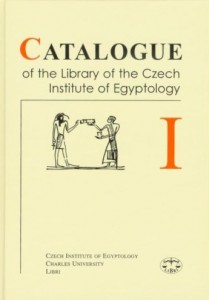 |
Jiřina Růžová Catalogue of the Library of the Czech Institute of Egyptology I Czech Institute of Egyptology – Libri, Prague 1999 This is a useful listing of the volumes in the library of the Institute of Egyptology, a helpful source of bibliographic information. While this sort of information is nowadays better presented online, the volume may be of interest to scholars because of the titles from Eastern Europe and Russia which the Czech Institute has available in its collections. available, contact distributors |
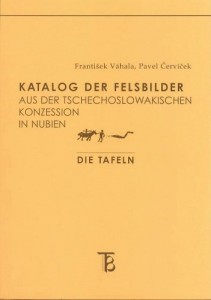 |
František Váhala – Pavel Červíček Katalog der Felsbilder aus der tschechoslowakischen Konzession in Nubien, vol. I-II Charles University, Karolinum, Prague 1999 This two-volume publication presents over 1000 reliefs and 39 paintings recorded by Czech archaeologists as part of the UNESCO project to salvage antiquities threatened by the rising waters of damming projects. Ranging from 4000 to 1000 years old the artworks constitute important source materials for our understanding of Egyptian-Nubian relations over a long period of time. The position, characteristics and bibliographic references are presented for each site, while each is also illustrated by line drawings. Text in German. available, contact distributors |
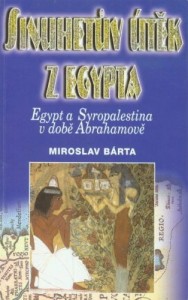 |
Miroslav Bárta Sinuhetův útěk z Egypta Set-Out, Prague 1999 Czech original of Sinuhe, the Bible and the Patriarchs. |
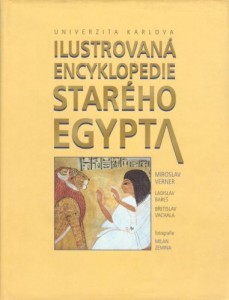 |
Miroslav Verner – Ladislav Bareš – Břetislav Vachala – Milan Zemina (photography) The Illustrated Encyclopedia of Ancient Egypt Charles University in Prague, Karolinum, Prague 1998 A clear and richly illustrated encyclopedia, covering all aspects of ancient Egyptian culture, history and archaeology. It is the only original Czech publication of its kind, it includes Czech standards for the Czech transcription of ancient Egyptian names, as well as a useful overview of the history of Egyptology. Text in Czech. |
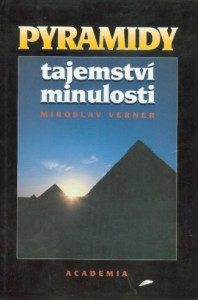 |
Miroslav Verner Pyramidy, tajemství minulosti Grove Press, New York 2001 This book uncovers the veil covering the creation, construction and history of the pyramids. The author introduces the individual Egyptian pyramids and their builders. The book exists in Czech, English (The Pyramids, Grove Press New York 2001) and German version (Die Pyramiden, Rowohlt 1998). |
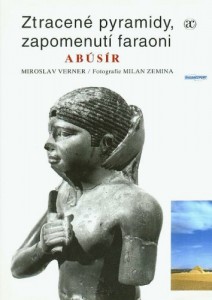 |
Miroslav Verner Lost Pyramids, Forgotten Pharaohs, Abusir Academia, Prague 1997 This volume is addressed to the general public with interest in the history and culture of ancient Egypt. It relates to the reader the results of the work of Czech Egyptologists at Abusir from the beginning of their excavation at this site to the mid 1990s. The book exists in Czech, English and German versions. PDF available from Electronic publications |
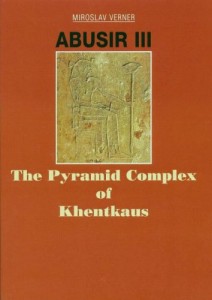 |
Miroslav Verner Abusir III. The Pyramid Complex of Khentkaus Charles University in Prague and Academia, Prague 1995 The unique pyramid complex of Khentkaus (the ‘mother of two kings’ who lived around 2500 BC) was discovered by the Czech Institute of Egyptology in 1976. This volume provides the final report on the excavation as well as specialist reports on the masons’ marks, the fragments of papyri and reliefs, and the sealings. It also contains an evaluation of the architectural remains and some conclusions about what this find tells us about Egyptian history at the beginning of the 5th Dynasty. available, contact distributors PDF available from Electronic publications |
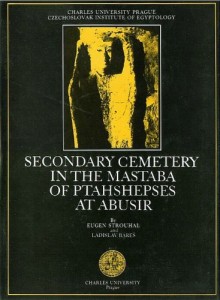 |
Eugen Strouhal, Ladislav Bareš Secondary Cemetery in the Mastaba of Ptahshepses at Abusir Charles University, Czech Institute of Egyptology, Prague 1993 This large-format excavation report describes work at a large mastaba tomb which was used for successive burials between the 7th Century BC and 1st Century AD. There are chapters on the burials in and around the monument, the coffins and funeral equipment, demography, burial rites, the human and accompanying animal bones. available, contact distributors PDF available from Electronic publications |
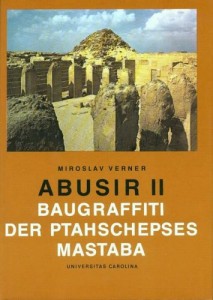 |
Miroslav Verner Abusir II. Baugraffiti der Ptahschepses Mastaba Czech Institute of Egyptology, Prague 1992 The publication of building graffiti found on the walls of the Mastaba of Ptahshepses. Building graffiti represent an important source of information about the organization of ancient Egyptian construction works, their creation and the people who had built them. last copies PDF available from Electronic publications |
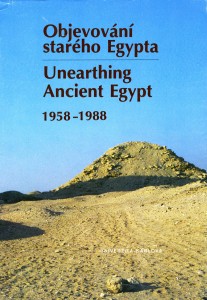 |
Miroslav Verner et al. Unearthing Ancient Egypt / Objevování starého Egypta 1958-1988 Czech Institute of Egyptology, Prague 1990 Presented in both Czech and English this book commemorates work by the Czech Institute of Egyptology in Egypt between 1958 and 1988. The topics covered are: The international UNESCO campaign to save the monuments of Nubia; work at the Mastaba of Ptahshepses at Abusir; work in the South Field at Abusir; an overview of Czech Egyptological Expeditions and a bibliography of Czech Egyptological publications. Text in Czech and English. last copies (OXBOW only) PDF available from Electronic publications |
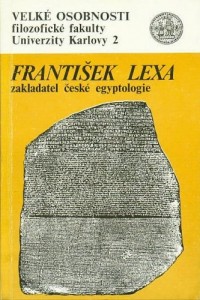 |
František Lexa: The Founder of Czech Egyptology / Der Begruender der tschechischen Aegyptologie Charles University, Prague 1989 This bilingual publication (in Czech and in German) describes the life and work of the founder of Czech Egyptology Prof. František Lexa. last copies PDF available from Electronic publications |
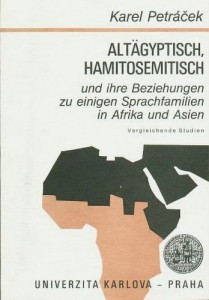 |
Karel Petráček Hamitosemitisch und ihre Beziehungen zu einigen Sprachfamilien in Afrika und Asien Czechoslovak Institute of Egyptology, Prague 1988 An important text for discussing the relationship between Egypt and the rest of Africa, this monograph by an eminent Czech scholar traces the linguistic roots of Egyptian and Semitic languages. Text in German. available, contact distributors |
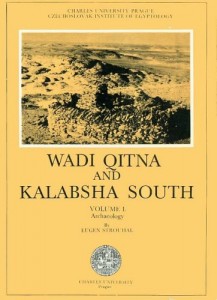 |
Eugen Strouhal Wadi Qitna and Kalabsha South, vol. I. The Archaeology Czech Institute of Egyptology, Prague 1984 Wadi Qitna is located in Egyptian Nubia, 65 kilometers south of Aswan, on the west bank of the Nile. The cemetery here occupies the slopes and adjacent high ground along the edges of the valleys, with the highest concentrations of graves situated along rock outcrops where stone was readily available. This book describes excavations at the Roman and Byzantine tumulus graves and the finds unearthed, particularly the pottery which forms the basis of the Eastern Desert Ware type. available, contact distributors |
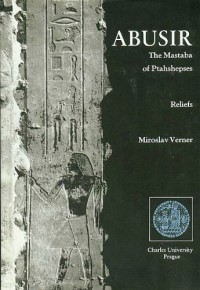 |
Miroslav Verner This two-volume work is dedicated to the analysis and publication of the reliefs preserved in situ in the area of the mastaba of Ptahshepses. The first volume contains the text, the second consists of the drawings of the individual reliefs. PDF available from Electronic publications |
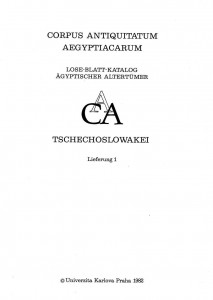 |
Miroslav Verner CAA Tschechoslowakei Lieferung I: Altagyptische Saerge in den Museen und Sammlungen der Tschechoslowakei Czech Institute of Egyptology, Prague 1982 This huge volume of loose-leaf text and plate pages constitutes volume 1 in the Corpus Antiquitatum Aegyptiacarum for the Czech Republic. Mummy cases from the extensive Czech collections are catalogued and discussed in detail, and each example is shown in black and white photographs. Text in German. available, contact distributors PDF available from Electronic publications |
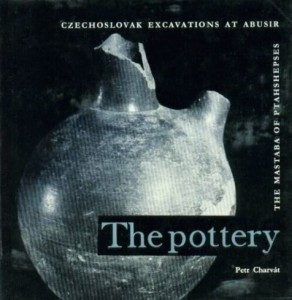 |
Petr Charvát The Mastaba of Ptahshepses. The Pottery (Czechoslovak Excavations at Abusir) Charles University, Prague 1981 Ptahshepses was vizier to Sahure. The magnificent mastaba tomb is second only in size to that of Mereruka at Saqqara. First excavated in 1893, work between 1960 and 1974 by the Czech Institute has shed more light on the more mundane materials left by the earlier excavators. This volume presents a full analysis of the pottery found in the tomb. While most of book is devoted to a catalogue, there are some useful and thoughtful discussions of how different types of vessel were made. last copies |
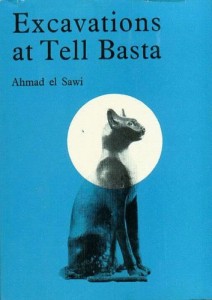 |
Ahmed el-Sawi Excavations at Tell Basta. Report of Seasons 1967-1970 and Catalogue of Finds Charles University, Prague 1979 Tell Basta (Bubastis or Per-Bastet) is the site of an ancient city about 60 miles NE of Cairo. Occupying a key position on routes between the Sinai and Memphis the city appears to have been founded in the 4th Dynasty but remained important until Roman times. During 22nd and 23rd Dynasties the city reached its peak of power, possibly even becoming capital of Egypt under Osorkon I (924 to 889 BC), a native of Bubastis. This volume describes work by the Czech Institute at the site. available, contact distributors |
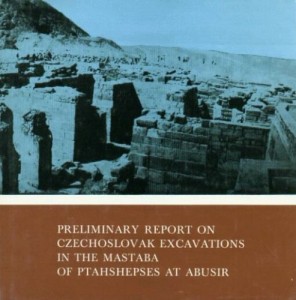 |
Zbyněk Žába – Miroslav Verner et al. Preliminary Report on Czechoslovak Excavations in Mastaba of Ptahshepses at Abusir Czech Institute of Egyptology, Prague 1976 Ptahshepses was a high official of the 5th Dynasty pharaoh Sahure. His mastaba was first discovered in 1893 but proper investigation was left to a series of Czech expeditions which mapped and excavated the site between 1960 and 1974. This book contains preliminary reports on the 7 expeditions and special studies on: The geodetic documentation survey; The architecture; The reliefs; The inscriptions and marks on masonry blocks; Secondary burials; Coffins of secondary burials; Pottery; The pillar system of the pillar court; The eight-stems columns of the East portico. The book is well illustrated. available (OXBOW only) PDF available from Electronic publications |
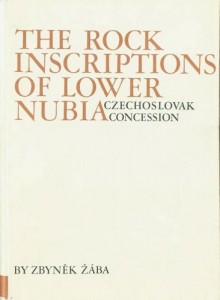 |
Zbyněk Žába The Rock Inscriptions of Lower Nubia, Czechoslovak Concession Czech Institute of Egyptology, Prague 1974 This huge book records 293 inscriptions on rock from the area which the Czech Institute took responsibility for surveying as the waters of the Aswan dam rose. This was a region 100 km long, extending between the famous temples of Kalabsha and Gerf Hussein. Most of the inscriptions are in Egyptian, dating from the 1st Dynasty down to the Coptic period with a particularly large number from the early 12th Dynasty (shedding new light on the conquest of Nubia under Amenemhet I and Senwosret I). The remaining inscriptions were written in Greek, Latin, Carian, Meroitic and Aramaic. Each inscription is translated, discussed and given both location and date. Each is also shown in a black and white photograph and transcribed. available, contact distributors PDF available from Electronic publications |
 |
Miroslav Verner Some Nubian Petroglyphs on Czech Concessions Czech Institute of Egyptology, Acta Universitatis Carolinae, Philologia Monographia XLV 73, Prague 1973 This book presents results of work by the Czech Institute to catalogue rock art later covered over by the waters of the Aswan High Dam. The symbols discovered are grouped into: Foot and sandal prints; Signs and symbols and Erotica. Despite the problems of dating rock art, the different types of mark discovered seem to show a long tradition and, as well as cataloguing the material, this book contains some interesting discussion about what the marks meant and how they were used. available, contact distributors PDF available from Electronic publications |